|
|
|
Reviews and Observations on
Silent Westerns
by Boyd Magers |
As the forerunner of the sound westerns we all enjoy, the silent westerns that still exist deserve our consideration and attention. As seemed to be the custom of the day, you’ll notice in silents many of the cowboy heroes mix light comedy with hard action. This style was carried over into talkies primarily by Hoot Gibson, but to a lesser degree by Ken Maynard and Buck Jones, eventually giving way to straight action from the star of the film with the comedy elements left to the sidekicks (Gabby, Fuzzy, Smiley, etc.) Silent westerns also exhibited stronger roles for women and usually more romance than in the sound era B-westerns.
For specific stars or titles, use your "Find on this page" feature on your computer.
The
Ratings |
|
|
Average
 
|
Very little of Interest

|
Not Worth
your time!

|
Posted 8/17/08
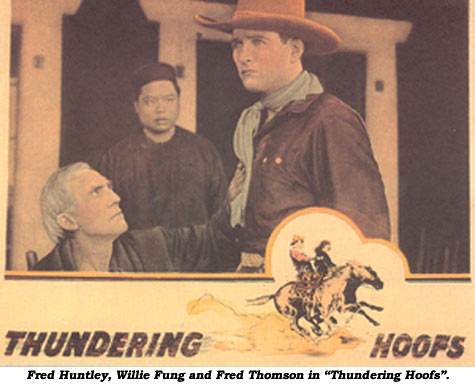
    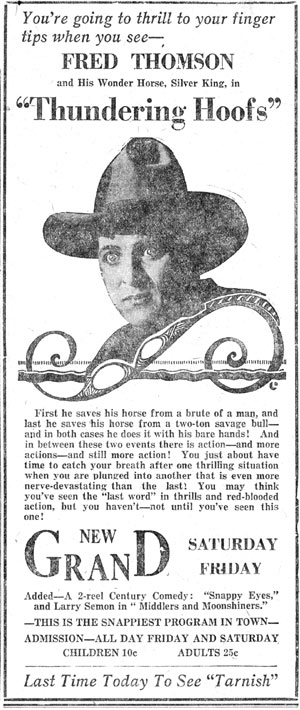 THUNDERING HOOFS (1924 FBO) 47 minutes THUNDERING HOOFS (1924 FBO) 47 minutes
Fred Thomson was a great western star in the Tom Mix mold, his popularity even rivaled Mix’s until Joseph P. Kennedy entered the scene. Thomson was born February 26, 1890, in Pasadena, CA, the son of a Presbyterian minister. Planning to be a minister himself, he meanwhile excelled in collegiate sports at Occidental College from 1905-1910. Leaving Occidental, he went to Princeton to continue his ministry studies, again excelling in sports. Ordained a minister, he served in Washington, D.C., Los Angeles and Goldfield, Nevada. Tragedy struck in 1916 when his wife of less than three years died. Then came WWI and Fred became Chaplain of the 143rd Field Artillery and went overseas with the 40th Division. Following the Armistice, at the Inter-Allied Games in Paris, Fred met screenwriter Frances Marion. They fell in love and were married in Paris before their return to the U.S. With his wife’s help, he broke into pictures playing Mary Pickford’s husband in THE LOVE LIGHT in ‘21. Gravitating toward westerns, Fred found Silver King at a riding Academy in New York and purchased the horse. Fred was an instant hit in his first western, THE MASK OF LOPEZ. He signed with FBO who insisted on top quality in their westerns, which made all of Thomson’s films a cut above many others. One hit western followed another from 1924 through 1927. Midway, Boston-financier Joseph P. Kennedy put together an investment group that resulted in his taking over three movie studios in the mid-‘20s, including FBO, and running them as he would a financial institution. At some point, Kennedy put Thomson under personal contract. Becoming a major star, Thomson was courted by Paramount. Kennedy agreed to “loan out” Thomson to Paramount at $100,000 a picture for four super-westerns. The first of these was JESSE JAMES in ‘27. (His wife wrote the script.) PIONEER SCOUT, SUNSET LEGION and KIT CARSON followed in ‘28. Thomson’s popularity soared, he was now second only to Mix among male stars. With the decade winding down and talkies around the corner, after the four films, Paramount declined to renew the contract with Kennedy for Thomson’s starring services. At the same time, the ever devious Kennedy had just signed Tom Mix as an FBO star, with his first film SON OF THE GOLDEN WEST in late ‘28. Thomson apparently knew nothing of Kennedy’s behind the scenes machinations. It seems Kennedy was ready to divest himself of Thomson, figuring he had wrung just about everything he could from him. Thomson returned to Paramount who agreed to sign him directly—without all the fees to Kennedy coming off the top, but this would require Fred to get free of his of his personal contract to Kennedy. However, Kennedy refused to release Fred. Speculation is, with Mix now in the FBO fold, Kennedy wanted no competition from Thomson westerns. Assuring Fred and Frances “something would work out”, Kennedy suddenly became “unavailable.” Unable to fight the legal nightmare, unable to work, Fred slid into depression. Six months later, on the evening of Christmas Day, 1928, Fred died at 38. Officially, his death was attributed to tetanus. Apparently, Fred had stepped on a rusty nail at some point and disregarded it. But Frances Marion told friends Fred had lost the will to live. Sadly, due to Joseph Kennedy, the western world lost a great star who, with obviously a good voice as he had been a minister, could easily have gone on to great things in sound westerns. Obviously, Thomson put too much faith in the shrewd, uncaring Kennedy by signing a personal contract. Kennedy came to Hollywood in 1926 and walked away with millions four years later, leaving behind a trail of bankrupt businessmen and devastated careers. Kennedy’s bottom line had always been to make a fortune for himself and his family, and lookout to anyone who got in his way.
Sadly, only a couple of Fred’s films survive today for viewers to thrill to his exploits. Thrilling daredevil stunts highlight THUNDERING HOOFS as devil-may-care Fred saves Spanish Don Estrada’s daughter, Ann May, in a spectacular stagecoach sequence and falls in love with the beauty, and she him, although she is promised by her father to William Lowery who, unbeknownst to all, is a bandit leader. To get his daughter away from Fred, the devious Don spirits his daughter back to Mexico, but Fred follows. Once in Mexico, Fred is captured and imprisoned by the cruel, vindictive Lowery who then offers Fred’s steed, Silver King, up to be slaughtered in the bullring. Miraculously, Fred escapes, wrestles the bull, saves Silver King, defeats Lowery, wins the respect of the girl’s father and the love of Ann.
Incidentally, you think Tony, Tarzan, Champion and Trigger were smart? In THUNDERING HOOFS, when Fred ‘s father dies, Silver King digs a grave, makes a cross, buries Fred’s father and kneels at his graveside. Top that!
Pay particular attention to that stagecoach sequence. Fred was making the transfer from horse to stage when the wheel horse went down, throwing Fred who was badly hurt. Yakima Canutt completed the scene with his famed stunt of going under the coach, grabbing the back end and pulling himself up.
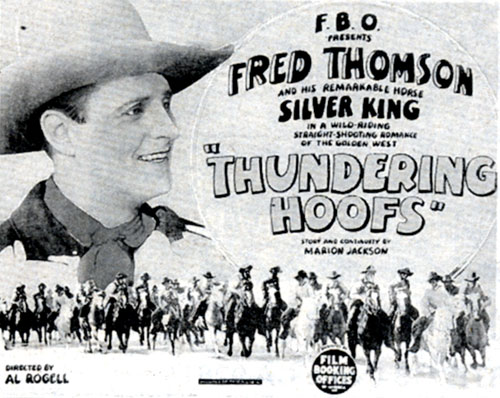
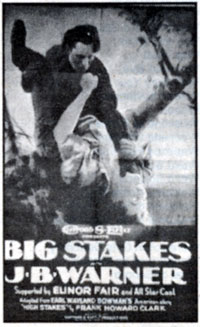    BIG STAKES (1922 East Coast) 51 minutes BIG STAKES (1922 East Coast) 51 minutes
Sort-of a cross between Tom Tyler, Buck Jones, Fred Thomson and Smith Ballew, J. B. Warner coulda been a major western star had he not succumbed to TB at 29. In BIG STAKES Elinor Fair, the proud Castillian daughter of Don Enrico, master of a large Mexican rancho, is betrothed to the Commandante of Sonora, Mexico, Capitan Robert H. Gray, but she shows a romantic interest in devil-may-care Americano J. B. Warner who is not taking life too seriously until he meets Fair. Infuriated with Fair’s interest in Warner, Gray has Warner and his tubby comedic sidekick, H. S. Karr, captured and brought to Sonora. Gambling for his life, Warner challenges Gray to a deadly contest with the victor winning Fair and the loser forfeiting his life to the bite of a poisonous Gila Monster. A secondary plot has an American enemy of Warner’s, bullying Les Bates, leading a band of Klan-like night-raiding marauders. To wreak vengeance on Warner, Bates has captured an American girl, Wilamae Carson (who is also fond of Warner), in order to lure Warner into a revengeful trap. There are several surprises, and big stakes, in order before it’s over.
Talented producer/director Clifford S. (Sanford) Elfelt, born February 15, 1890, in Chicago, Illinois, was a former cigar salesman and operator of a movie exchange who became a director at Universal in 1916 and Fox in 1917. It is Elfelt who spotted Warner when the cowboy made several two reelers at Universal, saw great potential in him and signed him to star in features for Elfelt’s East Coast Productions. (Incidentally, Elfelt cast his former wife, minor actress June La Vere [real name Gladys Elfelt], in Warner’s DANGER in ‘23.) When Warner then signed with Sunset, Elfelt hooked up with fledging Davis Productions to produce Ken Maynard’s first westerns (including $50,000 REWARD. DEMON RIDER, etc.). Unfortunately, Davis floundered and Elfelt went bankrupt. He left films altogether in 1926 after directing Bill Patton in UNDER FIRE for Davis. (Thanks to Evy Patrick for early years research.)
James B. Warner was born in Chadron, Nebraska. His father was William H. Tobias but J. B. was raised by his mother’s parents whose name was Warner. J. B. legally changed his name to Warner, considering his grandparents his father and mother. He was not the brother of film star H. B. Warner as is often reported. J. B. entered the Army in 1917 and was discharged as a Corporal two years later. It was then he came to the attention of Universal, probably at first as a riding extra.
  DARKENING TRAIL (1915 Mutual) 39 minutes DARKENING TRAIL (1915 Mutual) 39 minutes
Not an action picture or even a good-badman role for William S. Hart, but a human drama very adult in nature. Playboy cad George Fisher brushes off pregnant Nona Thomas for good time dancehall gal Louise Glaum. When Fisher’s father learns of his son’s indiscretion, he threatens to disown him unless he marries the girl. Unwilling to do so, Fisher flees to the Yukon. Disliked by the Alaskans because of his superior attitude he is befriended by Yukon store owner Enid Markey. Rough-house trapper William S. Hart is in love with Markey, but when he sees her take up with Fisher he steps aside. Knowing he has lost the girl, he forces Fisher “to do the right thing” and marry Enid. But Fisher hasn’t changed, he remains no good, even when Enid falls deathly ill with pneumonia he prefers to let her die rather than go for a doctor. Hart finds Fisher in a bar with a whore and goes for the doctor himself but it is too late. As Markey’s last words were to not die “alone,” Hart brings the drunken Fisher to Markey’s deathbed, pulls his gun and sends the heartless Fisher on “the darkening trail”.
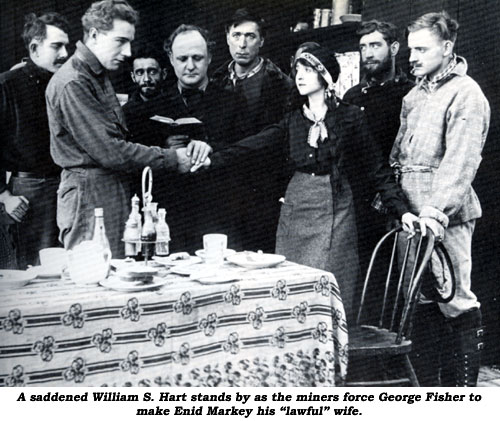
   NAKED HANDS (1918 Modern Method Prod.) 23 minutes NAKED HANDS (1918 Modern Method Prod.) 23 minutes
From 1910-‘16 G. M. Anderson made his Broncho Billy characterization legendary. When he sold his half-interest in Essanay in 1916, he retired his alter-ego but revived Broncho Billy in 1918 when he established Golden West Producing Corporation with producer T. Lawrence Weber. A few months prior to this, in 1917, Anderson had launched a five-reel feature, HUMANITY, but Anderson’s former partner, George Spoor, through legal machinations, prevented the release of the film. Anderson cut a reel from the film and tried to release it independently as NAKED HANDS but the film failed at the boxoffice. The picture reappeared a year later as part of Anderson’s distribution deal. Foreign distribution was handled by Weber who financed the set-up with Anderson. Weber later obtained rights to the features and recut the five-reelers into tightly edited two-reelers. NAKED HANDS was one of these. ^ ^ Just as hard-rock miner Billy finally discovers gold in the desolate desert, his lonesome-for-attention wife (Ruth Saville) runs off with a New York stockbroker, an old flame of hers (Rodney Hildebrand). Two years’ time passes for the heartbroken Billy who is now a rich mine owner while his ex-wife regrets her decision to run away and marry the callous, uncaring New Yorker. Pining away for Billy, she is dying but by the time she sends for Billy it is too late. With his naked hands, Billy swears to kill the cad who wrecked their lives and nearly does before making a startling discovery.
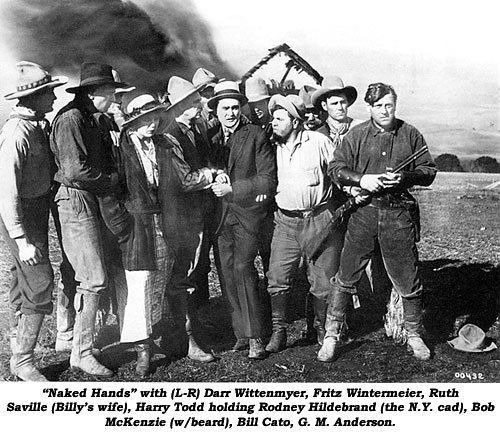
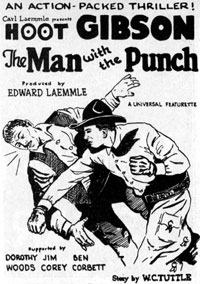   THE MAN WITH THE PUNCH (1920 Universal) 18 minutes THE MAN WITH THE PUNCH (1920 Universal) 18 minutes
After service in WWI (the tank corps in France) director John Ford and western star Harry Carey helped Hoot Gibson get a foothold at Universal, at first supporting Pete Morrison in a series of two-reelers. In 1919 Hooter began starring in his own series of two-reelers, assuming the role of a lighthearted cowboy who was the exact opposite of the grim William S. Hart, the flamboyant Tom Mix or the realistic Harry Carey. The public took to the down-to-earth comedic Hoot, his films appealed as much to Mom and Dad as they did the kids—perhaps more. In this two-reeler, Hoot, mistaken for a bandit, is hired by crooked sheriff Jim Corey to hold up the stage, but Hooter turns the tables on him.
    $50,000 REWARD (1925 Davis) 47 minutes $50,000 REWARD (1925 Davis) 47 minutes
Few western fans would argue that Ken Maynard was one of the greatest movie cowboys ever to ride the screen. Born in Vevay, IN, July 21, 1895, Ken ran away from home at 12 to join a shabby little wild west show. His father returned him to home, but at 16 Ken was granted permission to join a touring carnival. In 1913, at 19, Ken was with Buffalo Bill’s Wild West Show. In 1914 Ken was with the Kit Carson Wild West Show and in 1915 it was the Hagenbeck and Wallace Circus. Following civil engineer service in WWI, Ken was back with Hagenbeck and Wallace in 1918, Pawnee Bill’s Show in 1919 and Ringling Brothers in 1920. With Tom Mix and Buck Jones urging Ken to come to Hollywood, he signed with Fox but they used him only in supporting roles. Leaving the major studio, he accepted an offer to play Paul Revere in Cosmopolitan’s JANICE MEREDITH (‘24). His riding ability noticed, independent Davis Films signed him for a series with DEMON RIDER being his first in ‘25 followed by $50,000 REWARD which features some terrific horsebacking and thrilling stunts. Viewing the film today you can immediately see why Ken made such a splash on the screen. Moving along at a lightning pace under the direction of Clifford S. Elfelt (See BIG STAKES) and photography of Bert Longnecker, fun-loving Ken owns the desert land below a dam that will soon be irrigated and made valuable. Leading lady Esther Ralston takes over as engineer of the dam project for her ailing father, and Ken quickly is smitten by the girl. But there’s trouble brewing. Bank president Frank Whitson and crooked lawyer William Moran want Ken’s valuable property so for $50,000 reward they hire Edward Peil, leader of a lawless outfit, to obtain incriminating ownership papers from Ken. Note that the film contains a very blatant racial slur. The dam used in the picture was St. Francis dam near Los Angeles which burst in 1928 causing a terrible disaster.
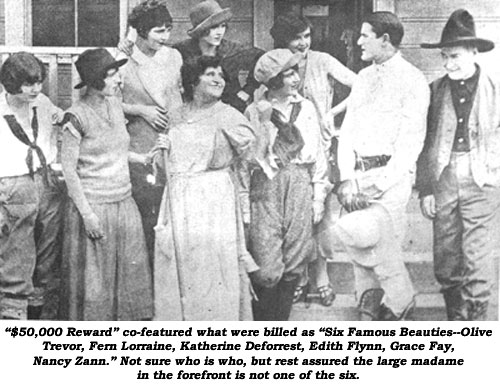
 THE EXTRA MAN AND THE MILK-FED LION (1916 American) 27 minutes THE EXTRA MAN AND THE MILK-FED LION (1916 American) 27 minutes
The Buck Parvin short stories came from the pen of Charles Van Loan whose interest in the fledging film industry became the source for Buck Parvin’s exploits as a movie cowboy. In 1915 Art Acord was signed to portray Buck Parvin on screen. This is the 7th in the Parvin series. Unfortunately, the Blackhawk Films edit of this original three-reeler down to two-reels leaves out some important plot points. Basically a comedy, Art and his pal (S. William Marshall) lose a boxing match to a Kangaroo, screw up director Lawrence Peyton’s film, and lose the respect of leading lady Dixie Stratton. “Women and lions, look out for ‘em,” Art tells his pal. “Kangaroos too!” The Parvin series completed in 1917, Art entered WWI and later became a major western star in the ‘20s.
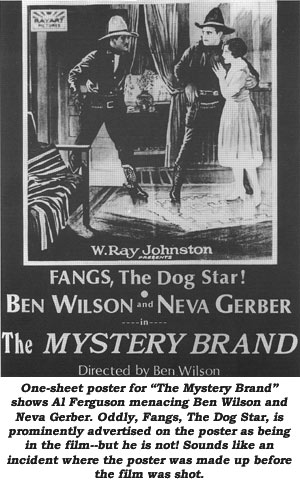  MYSTERY BRAND (1927 Rayart) 52 minutes MYSTERY BRAND (1927 Rayart) 52 minutes
With the previous sheriff annihilated, and no one else to take the job, Lafe McKee and a citizens’ committee appoint town lazybones Ben Wilson sheriff to track down a rustling gang. To win the heart of the girl he loves (Neva Gerber), Ben must prove he is up to the task of capturing the ringleader of the Mystery Brand rustlers (Al Ferguson). Talk about slow, this film’s pace is glacial! (Surviving print has been crudely retitled LARIAT’S END for some obscure reason.) Born in 1876 in Clinton, Iowa, Ben Wilson got in on the ground floor of early filmmaking as actor/director/producer and jack of all trades. He had his hand in about every nook and cranny of the fledging film business. As an actor he was on screen in over 200 films. One of the most popular and successful serial stars of the silent era, he teamed with Neva Gerber (as he does here) for eight serials and at least 13 shorter films. From ‘24-‘27 Wilson produced/directed and starred in westerns for Arrow, Davis and Rayart. Fifty-one years old when he made MYSTERY BRAND, save for a couple more his starring days were over. Wilson turned to directing westerns for Al Hoxie and Cliff Lyons, even the first legitimate sound serial, THE VOICE FROM THE SKY starring Hal Taliaferro (Wally Wales) for G.Y.B. Films in 1930. Wilson’s former leading lady Neva Gerber co-starred. As an actor Wilson’s last film was Columbia’s SHADOW RANCH with Buck Jones (‘30). Wilson died of a heart attack August 25, 1930.
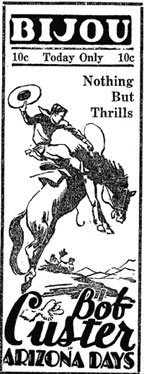     ARIZONA DAYS (1928 Syndicate) 44 minutes ARIZONA DAYS (1928 Syndicate) 44 minutes
A definite contender for the best Bob Custer of all his silent and sound westerns. Directed by, and featuring as the main heavy, J. P. McGowan, whose work could be quite slipshod, he definitely put some care and effort into ARIZONA DAYS both in directing and acting. Nothing out of the ordinary in the plot, it’s just the endeavor to make a better than usual B-western is obvious on the screen, including a vigorous fight midway between Custer and McGowan. Plotline has rancher John Lowell Russell mixed up in rustling with McGowan and his boys Mack V. Wright (who, at this point in his career was still mixing acting with directing, as was McGowan) and Hank Bell. When Russell’s daughter, Peggy Montgomery, looking more fetching than ever, declares her intent to turn them in to the law, along comes Bob Custer with other ideas. It’s worth your time to see why!
   $5,000 ELOPEMENT (1916 Selig) 8 minutes $5,000 ELOPEMENT (1916 Selig) 8 minutes
Tom Mix wants to elope with his girl (Victoria Forde) but first he must help his sweetheart’s dad (Joe Ryan) recover $5,000 stolen by bandits (Chet Ryan, Sid Jordan).
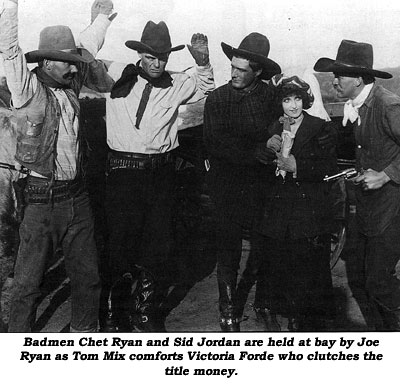
  AN ARIZONA WOOING (1915 Selig) 12 minutes AN ARIZONA WOOING (1915 Selig) 12 minutes
Both Tom Mix and outlaw Mexican Joe (Pat Chrisman) are in love with the same girl (Bessie Eyton). Less a comedy and more a quick action piece than many of Mix’s Selig one-reelers.
  FIGHTING FOR GOLD (1919 Fox) 17 minutes FIGHTING FOR GOLD (1919 Fox) 17 minutes
A London-based mining company tries to extricate Tom Mix from his claim in these brief surviving excerpts from the earliest example of Tom’s Fox feature work.
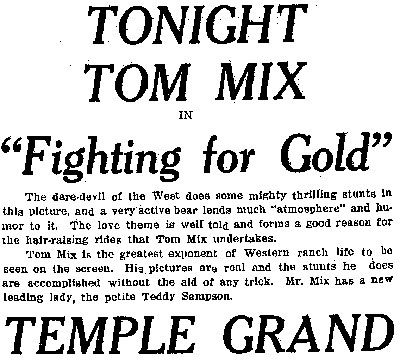
 RIDING FOR LIFE (1926 Rayart) 60 minutes RIDING FOR LIFE (1926 Rayart) 60 minutes
Outlaws Bob Fleming and Bud Pope attempt to frame star Bob Reeves’ kid brother (Hal Waters) into helping them rob the express office. Even with a story by future director Joe Kane, script by prolific Ray Johnston and direction by Mack V. Wright, this is an uninspired, lifeless little western melodrama in which nothing much happens til the final 10 minutes. There’s barely enough here for a good two-reeler but it’s stretched out to an hour. 6' 2" Robert Jasper Reeves, born near Marlin, Texas, January 28, 1892, attended Texas A&M, likely on a baseball scholarship, and had a ranching and rodeo competition background before he came to Hollywood circa 1919. Universal head Carl Laemmle was impressed with the 27 year old cowboy and cast him in the 18 chapter ELMO THE MIGHTY with Elmo Lincoln.
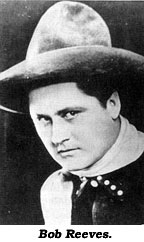 Bob then co-starred with Cleo Madison and Eileen Sedgwick in the 18 chapter GREAT RADIUM MYSTERY (‘19). Throughout the ‘20s Reeves starred in two-reelers and features for Cactus Features, Universal and Anchor, as well as playing supporting roles in several with Fred Thomson and Hoot Gibson. When his Anchor series wrapped in ‘26, Reeves turned solely to supporting—even bit and extra roles—on into the sound era. Watch closely and you’ll spot him in early westerns with Ken Maynard, Buck Jones, Tim McCoy, Bob Steele, Hoot Gibson, Gene Autry, Charles Starrett, Three Mesquiteers, Don Barry and many others on through 1957’s PARSON AND THE OUTLAW. Reeves died of a heart attack April 2, 1960. Bob then co-starred with Cleo Madison and Eileen Sedgwick in the 18 chapter GREAT RADIUM MYSTERY (‘19). Throughout the ‘20s Reeves starred in two-reelers and features for Cactus Features, Universal and Anchor, as well as playing supporting roles in several with Fred Thomson and Hoot Gibson. When his Anchor series wrapped in ‘26, Reeves turned solely to supporting—even bit and extra roles—on into the sound era. Watch closely and you’ll spot him in early westerns with Ken Maynard, Buck Jones, Tim McCoy, Bob Steele, Hoot Gibson, Gene Autry, Charles Starrett, Three Mesquiteers, Don Barry and many others on through 1957’s PARSON AND THE OUTLAW. Reeves died of a heart attack April 2, 1960.
  TELL-TALE BULLET (1919 Capital) 3 minutes TELL-TALE BULLET (1919 Capital) 3 minutes
Neal Hart tracks down the man who killed his brother. Several great close-ups make this brief edit from a two-reeler worthwhile.
 RANGELAND (1922 Steiner) 4 minutes RANGELAND (1922 Steiner) 4 minutes
Neal Hart rescues Blanche McGarity from outlaws, then fights the ringleader on a cliff in this brief clip. Pretty hard to judge the overall feature from this clip which is all filmed in medium or distant shots so you never really get a view of Neal.
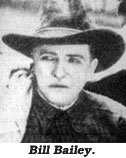   FIGHTIN’ JACK (1926 Goodwill) 47 minutes FIGHTIN’ JACK (1926 Goodwill) 47 minutes
Bill Bailey, as a neighboring rancher, helps pretty heiress Hazel Deane claim her rightful inheritance—a colossal ranch—despite opposition from a fraudulent Spaniard (John Byron), his girlfriend (Herma Cordova) and his foreman (Sailor Sharkey) who have taken illegal possession of the property. Pretty routine little western except for a couple of realistic brawls including a lengthy cat-fight between Deane and Cordova.
  THE TRAILER (1925 Wilcox and Wolcott) 24 minutes THE TRAILER (1925 Wilcox and Wolcott) 24 minutes
Man-trailer Frank Merrill (a future screen Tarzan) tracks down some rustlers (William Royle, Bob Fleming) in this routine two-reeler enlivened by the very athletic Merrill who had won 58 National, Southern California and L.A. gymnastics championships. He was National gymnastics Champion from 1916 to 1918. After a stint as a New Jersey Policeman he entered films as a stuntman.
  FANGS OF VENGEANCE (1926 Chesterfield) 21 minutes FANGS OF VENGEANCE (1926 Chesterfield) 21 minutes
In the Texas oilfields, wildcatter Lafe McKee is turned down for a loan at the bank. Meanwhile, Joseph Young, the beau of Lafe’s daughter Betty Baker, discovers Lafe’s foreman Dick Carter is mistreating his dog Fearless, so Young buys the animal. Next we discover Carter is in Cahoots with the head of Consolidated Oil, Ted Adams, to under produce, hoping Lafe’s oil leases will expire and the devious pair can take over. But Fearless discovers Carter’s trickery and turns the tables on his former owner. With Rin Tin Tin all the rage, every studio, major and minor, came up with a canine star. German Shepard Fearless starred in a dozen shorts in the mid ‘20s. Joseph Young (1900-1999) was the older brother of major-star-to-be Robert Young. Joseph Young also worked under the name Roger Moore. Ted Adams (1890-1973) is unbilled here, but in checking his existing credits, this two-reeler may be the former stage actor’s first film. Previously, the prolific heavy’s earliest known film was ROAD AGENT with Al Hoxie, also 1926. Ingénue Betty Baker had looks and talent and should have made more than the 10 films she did between 1925-1930, nearly all low-budget westerns.
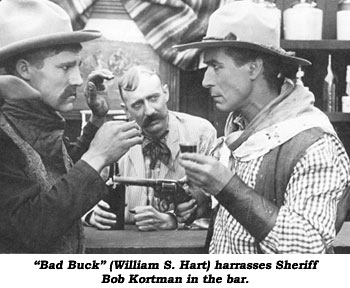
   BAD BUCK OF SANTA YNEZ (1915 Mutual, Kay-Bee) 20 minutes BAD BUCK OF SANTA YNEZ (1915 Mutual, Kay-Bee) 20 minutes
Although pursued by Sheriff Bob Kortman, whom he has ridiculed in town, valley troublemaker Bad Buck (William S. Hart) stops to help a pioneer woman who just lost her husband and whose little girl has been snake bitten. The delay could prove his downfall.
top of page
Posted 7/14/08
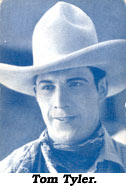   CALL OF THE DESERT (1930 Syndicate) 47 minutes CALL OF THE DESERT (1930 Syndicate) 47 minutes
From 1925 to 1929 Tom Tyler was FBO’s top western star. With the coming “threat” of sound, many studios curtailed their western output, including FBO. Tyler moved over to independent Syndicate where he made eight silent westerns as well as several talkies in ‘31. Left a map by his Dad to a mining claim in the desert, Tom has accepted the help and trust of treacherous Bud Osborne who steals Tom’s map and leaves him for dead in the desert. (In these early scenes, director J. P. McGowan took full advantage of a freak desert snowfall.) Tom is rescued by friendly desert rat Bobby Dunn and is nursed back to health at the nearby ranch of Sheila LeGay (later Sheila Bromley). Jealousy infuriates Sheila’s suitor, Cliff Lyons, and then, in a strange coincidental twist, Osborne turns out to be Sheila’s uncle! Osborne and Lyons overpower Tyler and set out to jump his claim and steal the gold from his mine, but Tom fights back and eventually brings Osborne and Lyons to justice and wins the love of Sheila. Filmed in Placerita Canyon and on the Jauregui Ranch.
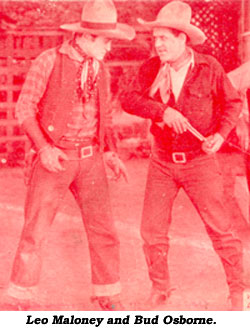     SMOKED OUT (1923 Pathé) 20 minutes SMOKED OUT (1923 Pathé) 20 minutes
Whenever one looks at Leo Maloney’s silent film career, considerable emphasis has to be awarded his Range Rider series of two-reelers. Twenty-six of these two-reelers were co-produced by Maloney and Ford Beebe in ‘22-‘23 with financial backing from Texas cattleman C. W. Patton. Credit is due to Maloney for maintaining a high standard of production on all these two-reelers, fortunately many of which still survive. Plot here has Maloney about to make night camp on the range when a stranger (Ray Meyers) who has been severely beaten and robbed, staggers into his camp. The man explains he was trying to reach his dying mother and begs Maloney to help him to her ranch. Upon arriving, Maloney is mistaken by the aged mom and her daughter, Pauline Curley—who’s never met her brother—for the long lost son. Maloney goes along with the error to prolong the mother’s life until the real son can be made presentable. Suddenly, the two crooks who beat Meyers (Bud Osborne, Pat Rooney) arrive at the ranch with Osborne proclaiming—with Meyers stolen identification—he is the long lost son in an attempt to gain possession of the property from the widow woman. Some good action in this fast moving, well directed two reeler, one of the best of Maloney’s Range Rider shorts.
    MAN TAMER (1927 Universal) 10 minutes MAN TAMER (1927 Universal) 10 minutes
Ed Cobb is in love with very cute Barbara Worth but she won’t marry him until he lowers his temper and stops fighting. When his rascally cousin forces Ed’s horse off the road, Ed falls and, unconscious for a while, develops amnesia and nearly marries a love-starved widow woman. Watch for a young Walter Brennan as the preacher. Well directed by Ernest Laemmle. Attractive Barbara Worth’s brief 19 film career over 13 years (‘23-‘35) is disappointing, as the brown-haired, blue-eyed Cincinnati gal had talent and looks. Of her 19 films, eight were westerns, co-starring in silents with Cobb, Hoot Gibson, Fred Gilman, Fred Humes and Jack Perrin. Her two talkie westerns were opposite Buddy Roosevelt and Kermit Maynard. She turned to screenwriting in the late ‘40s and scripted three pictures including “Dragnet” (‘47) (no relation to Jack Webb’s TV series) and “Zamba” (‘49).
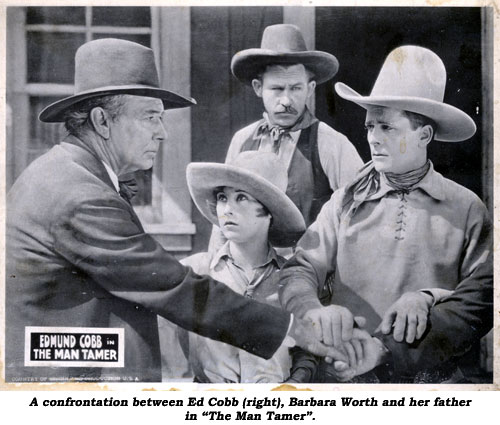
 SECRET OF THE PUEBLO (1923 Steiner) 41 minutes SECRET OF THE PUEBLO (1923 Steiner) 41 minutes
After building a career as a cowboy star in two-reelers and several features, in late 1921 Neal Hart set up his own production company to produce full length westerns for release by William Steiner Productions. In nearly all he directed as well as acted. Problem was, as a director Neal was no George Marshall, William Wyler or John Ford. SECRET OF THE PUEBLO offers a not uninteresting premise, but Hart’s drab, pedestrian direction severely muffles the film’s effectiveness. Plot has crooked mining engineer Monte Montague and devious lawyer John Blake trying to do a ranch owner out of his epread because they’re aware of a lost mine on the property. The mine, and a secret source of much needed water, are carefully guarded by a tribe of Pueblo Indians. (Probably the only western to ever villianize the peaceful handicraft Pueblos.) It’s Neal Hart to the rescue when the Indians hold the rancher’s daughter (Hazel Deane) prisoner.
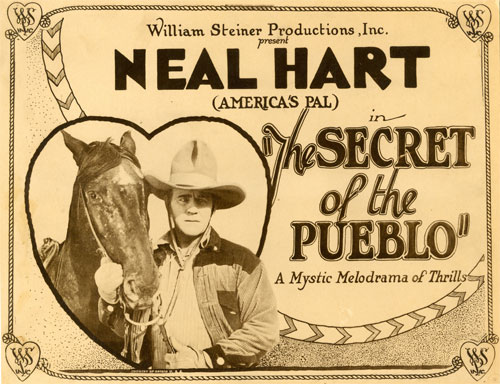
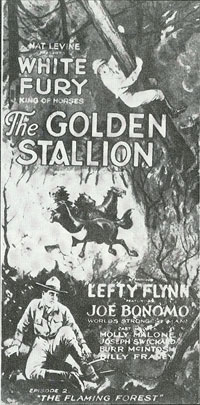    THE GOLDEN STALLION (1927, Mascot) 47 minutes THE GOLDEN STALLION (1927, Mascot) 47 minutes
It takes some mighty powerful editing to condense a 10 chapter serial down to 47 minutes but it’s been done here, however obviously leaving out a lot of plot points. Nevertheless, the condensed serial moves rapidly, making one wish the entire serial (Mascot’s first) had survived the ravages of time. In Cache D’Orr, ruthless trading post factor Joe Bonomo posts a $1,000 reward for The Golden Stallion (White Fury), leader of a herd of wild horses who has stolen Bonomo’s own horse. Meanwhile, back east, dying Josef Swickard sends his daughter Molly Malone west to decipher the secret of the Wampum Belt given to him years ago by an Indian, Black Eagle (Jay J. Bryan). At the same time, an Eastern fur magnate sends his nephew, Lefty Flynn, west to check on Bonomo and find out why this year’s fur catch is below par. Arriving out west, Flynn and Malone cross paths and team up with Black Eagle to find a lost mine to which the Wampum Belt combined with a key cipher branded upon the neck of the Golden Stallion will lead them. All the while Bonomo and his right-hand no-good, Tom London, try to steal the secret from them.   Although Jack Hoxie rode a horse named White Fury in a few films and made a serial for Mascot (HEROES OF THE WILD) the same year as THE GOLDEN STALLION, the two horses may or may not be the same. Photographs are inconclusive. Although Jack Hoxie rode a horse named White Fury in a few films and made a serial for Mascot (HEROES OF THE WILD) the same year as THE GOLDEN STALLION, the two horses may or may not be the same. Photographs are inconclusive.
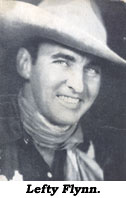 Maurice “Lefty” Flynn came to the screen from the Yale gridiron. The son of a successful contractor, Flynn was born May 26, 1892, in Greenwich, CT. Graduating from Yale in 1912 after excelling in baseball, track and football—he kicked with his left foot, hence his nickname—he may have played pro ball for a year or so, but that is probably studio publicity hype as there is no confirming documentation. An advocate of outdoor life, he is known to have worked as a deep sea diver and a hops picker with Indians and even did some stunts in THE SPOILERS (‘14) before drifting to Washington State looking for a ranch to purchase. When that didn’t materialize, he picked up some cowboy experience in Texas before his father bought him a ranch in Craig, Colorado, which he owned until his death on March 6, 1959. In the Navy during WWI he worked his way up to Lt. Jr. Grade. At the War’s end he was a naval aviation instructor in Miami, FL. Deciding to try acting, Lefty received billing in a 1919 Pathé comedy, OH, BOY. Sam Goldwyn offered him a contract but misused the athletic Flynn in drawing-room melodramas. He was better served at Fox in Zane Grey’s THE LAST TRAIL (‘22), then seemed to drift from role to role until FBO finally utilized Lefty’s ruggedness in a series of westerns and outdoor adventures from ‘24-‘26. His last film was this Mascot serial after which he retired to a business and social life (one that incidentally saw him marry five times and be involved in numerous affairs). Lefty ran the Camden, SC, golf tournament for years and was a regular in Newport, RI, social circles. Maurice “Lefty” Flynn came to the screen from the Yale gridiron. The son of a successful contractor, Flynn was born May 26, 1892, in Greenwich, CT. Graduating from Yale in 1912 after excelling in baseball, track and football—he kicked with his left foot, hence his nickname—he may have played pro ball for a year or so, but that is probably studio publicity hype as there is no confirming documentation. An advocate of outdoor life, he is known to have worked as a deep sea diver and a hops picker with Indians and even did some stunts in THE SPOILERS (‘14) before drifting to Washington State looking for a ranch to purchase. When that didn’t materialize, he picked up some cowboy experience in Texas before his father bought him a ranch in Craig, Colorado, which he owned until his death on March 6, 1959. In the Navy during WWI he worked his way up to Lt. Jr. Grade. At the War’s end he was a naval aviation instructor in Miami, FL. Deciding to try acting, Lefty received billing in a 1919 Pathé comedy, OH, BOY. Sam Goldwyn offered him a contract but misused the athletic Flynn in drawing-room melodramas. He was better served at Fox in Zane Grey’s THE LAST TRAIL (‘22), then seemed to drift from role to role until FBO finally utilized Lefty’s ruggedness in a series of westerns and outdoor adventures from ‘24-‘26. His last film was this Mascot serial after which he retired to a business and social life (one that incidentally saw him marry five times and be involved in numerous affairs). Lefty ran the Camden, SC, golf tournament for years and was a regular in Newport, RI, social circles.
Posted 7/4/08
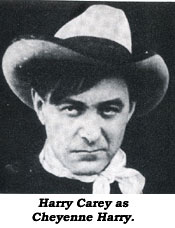   BUCKING BROADWAY (1917 Universal) 53 minutes BUCKING BROADWAY (1917 Universal) 53 minutes
BUCKING BROADWAY is most likely director John Ford's sixth feature film. Long thought to be lost, along with about 60 of Ford's 70 silent films, it was located in 2002 in the archives of the French National Center for Cinematography and subsequently restored. Harry Carey, who had the lead in 26 of Ford's films, is Cheyenne Harry, a cowboy working on L. M. Wells' ranch in Wyoming. Harry falls in love with Wells' daughter, Molly Malone, but is rebuffed when she, wooed by the big city charms of Vester Pegg, a wealthy visitor to the ranch, decides instead to elope to the Big Apple with Pegg. Resigned that he will not have Molly, Harry offers the girl a small wooden heart he has carved as a wedding present, telling her if she's ever in trouble to mail the heart back to him and he'll come-a-ridin' to her rescue. Once in New York (actually downtown Los Angeles), Molly quickly realizes what a sleaze Pegg is and what a terrible mistake she has made. Promptly sending the wooden heart to Harry, he and the ranch hands storm down Broadway to rescue Molly from the abusive grips of Pegg's decadent way of life. Possibly not Ford and Carey's greatest silent triumph, but what a treat to view what was believed a completely lost Ford western.
top of page
Posted 4/29/08
 NEVER AGAIN (1915 Selig) 9 minutes NEVER AGAIN (1915 Selig) 9 minutes
While he’s drunk, Tom Mix believes he’s shot and killed his best friend, Leo Maloney.
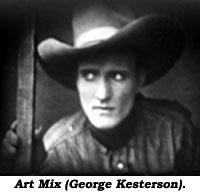  ACE OF CACTUS RANGE (1924 Aywon) 43 minutes ACE OF CACTUS RANGE (1924 Aywon) 43 minutes
Low budget director/writer/producer Victor Adamson (aka Denver Dixon) was the first actor to appear on screen as Art Mix for a series of westerns he produced in the early ‘20s. Tiring of the role, he hired George Kesterson (1896-1972) to assume the Art Mix role. Tom Mix tried but was unable to stop Adamson or Kesterson from using the Mix name, obviously done to cash in on Tom’s popularity. ACE OF CACTUS RANGE seems to be the first of the no-budget Adamson/Dixon directed Art Mix/Kesterson westerns. There’s no story other than U.S. Marshal Mix protecting and saving leading lady Virginia Warwick and her father from the clutches of an outlaw gang headed up by Clifford Davidson. Parting ways with Adamson by 1926, Kesterson kept using the name Art Mix as he drifted into roles as a heavy. This brought on several lawsuits and countersuits between the pair, but Kesterson kept the name, eventually appearing in hundreds of films on through the mid-‘40s.
 DOUBLE CINCHED (1923 PATHÉ) 24 minutes DOUBLE CINCHED (1923 PATHÉ) 24 minutes
On the day cowboy Leo Maloney and his girl Pauline Curley are to be married, escaped convict Bud Osborne waylays preacher Harry Belmour and switches clothes with him. Through a set of circumstances he is forced to “marry” the couple. Naturally all is rectified before Leo and Pauline consummate their marriage. Written and directed by Maloney and Ford Beebe, this two-reeler is played strictly for humor with a bit of roughhouse at the end. Together, between 1922-1923, Maloney and Beebe turned out some 26 two-reelers for their Malobee Company, all released by Pathé.
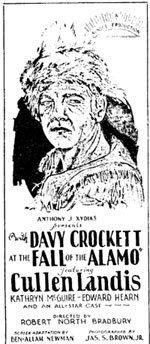  WITH DAVY CROCKETT AT THE FALL OF THE ALAMO (1926 Sunset) 34 minutes WITH DAVY CROCKETT AT THE FALL OF THE ALAMO (1926 Sunset) 34 minutes
In the mid-‘20s Sunset Productions released a series of six historical westerns produced by Grecian born Anthony J. Xydias (1879-1952). Three of them were directed by Robert North Bradbury who featured his son in all three. DAVY CROCKET… is badly dated considering all the Alamo films made since then, but looking at it from a 1926 perspective, it was undoubtedly well received. Cullen Landis is Crockett who, defeated in politics, heads to Texas to help defend the Alamo against Santa Ana (Fletcher Norton). The main reason to watch this today is to see an 18 year old Bob Steele play Alamo defender Pinky. In his first scene Bob is a lookout riding in to warn the fort that replacements will not be forthcoming. In Bob’s second scene he carries the Texas flag before being killed by Mexican soldiers. Xydias recycled the battle scenes from this film (and added sound effects) for his HEROES OF THE ALAMO in ‘37.
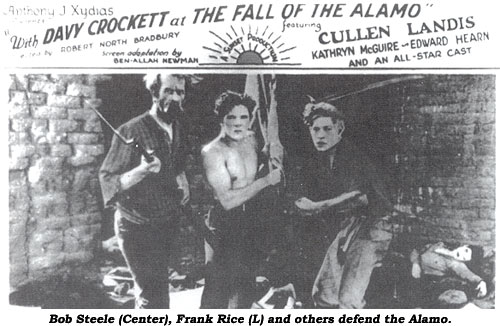
  SMOKING TRAILS (1924 Madoc) 61 minutes SMOKING TRAILS (1924 Madoc) 61 minutes
The head of a rustling gang (Jack House) is actually the foreman for cattle rancher William Bertram (who also directed the film). House is in league with money lender Maine Geary who has loaned money to Bertram. House and his right hand man, Tom Ross (described as a “jackal of the range”), steal Bertram’s cattle leaving his unable to pay Geary back, so Geary can then foreclose on Bertram’s ranch. Texas Ranger Bill Patton (and his horse Baldy) goes undercover as a ranch hand to expose their plot, all the while falling in love with Bertram’s daughter, Alma Rayford. But when Alma’s father is ambushed, she feels Bill is responsible. Would have been better as a two-reeler, at 61 minutes it takes too long telling its meager story, but is well directed and photographed with a final action flourish. Cowboy cancer alert: Bill drags on a cigarette and smokes a pipe. Note that the real life younger sister of prolific leading lady Alma Rayford, Adrian Rayford, plays the screen role here of Alma’s kid sister. This seems to be her only screen credit. Also note that badman Jack House (born 1887 in Cisco, TX/died in 1963 in Hollywood) was originally the stunt double for Rudolph Valentino, and is the real life father of boy-star Newton House (See WINGED HOOFS) as well as Dorothy House who became Mrs. Andy Devine.
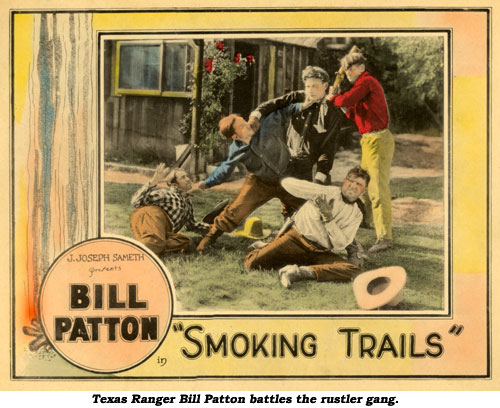
  HEART OF TEXAS RYAN (1917 Selig) 46 minutes HEART OF TEXAS RYAN (1917 Selig) 46 minutes
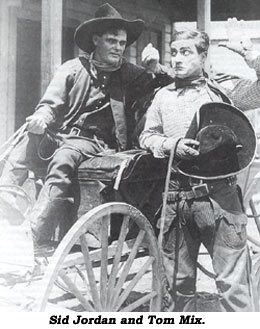 Originally planned as a Zane Grey adaptation of THE LIGHT OF WESTERN STARS, some sort of legal dispute over the rights forced Selig to restructure the film with a revised plot and new character names. Oddly, although Tom Mix is the obvious star, George Fawcett, Bessie Eyton and Frank Campeau all received billing over Mix in advertising. Tom did get top billing when the film was reissued in 1923 as SINGLE SHOT PARKER which is the version that exists today. Also note that the film contains a saloon fight lifted from Mix’s TELL TALE KNIFE (1914, Selig) with Leo Maloney and Hoot Gibson clearly recognizable in the footage. This footage may have been incorporated when Selig was forced to rework the aborted LIGHT OF WESTERN STARS or it may have been added for the SINGLE SHOT PARKER reissue. Plot has Bessie Eyton returning to Texas after two years away at school to join her ranch owner father Col. Ryan (George Fawcett) who nicknames her “Texas” Ryan. The hard-riding gal becomes the idol of the ranch hands, especially Single-Shot Jack Parker (Tom Mix). At this juncture, it’s apparent Tom’s films, be it shorts or features, included strong comedy elements as well as he-man action. Here, a drunken Tom nearly burns down the town fooling around with fireworks on the 4th of July. In so doing, tom incurs the wrath of Sheriff Frank Campeau who is the secret rustler ally of Mexican bandit William Ryno who, coincidentally, also favors—in a more lustful way—Texas Ryan’s charms. Hoping for ransom money, Ryno’s gang kidnaps Texas but Tom rescues her. When Ryno and his rustlers strike back, Tom, in a raging storm, outwits them and captures Ryno. But he soon escapes, sending Tom on another chase into Mexico where Tom is captured by Ryno’s gang. As he’s about to be executed by the outlaws, the film takes an odd turn, having Texas, now realizing she loves Tom, simply pay a ransom for his release. Definitely a strange—and weak—ending to an otherwise good western, making one wonder if something wasn’t lost in either the revision from LIGHT OF WESTERN STARS or in possibly some re-editing for the reissue as SINGLE SHOT PARKER. At any rate, it was Tom’s final film for Selig as he accepted an offer to star for the expanding Fox Film Corporation. Originally planned as a Zane Grey adaptation of THE LIGHT OF WESTERN STARS, some sort of legal dispute over the rights forced Selig to restructure the film with a revised plot and new character names. Oddly, although Tom Mix is the obvious star, George Fawcett, Bessie Eyton and Frank Campeau all received billing over Mix in advertising. Tom did get top billing when the film was reissued in 1923 as SINGLE SHOT PARKER which is the version that exists today. Also note that the film contains a saloon fight lifted from Mix’s TELL TALE KNIFE (1914, Selig) with Leo Maloney and Hoot Gibson clearly recognizable in the footage. This footage may have been incorporated when Selig was forced to rework the aborted LIGHT OF WESTERN STARS or it may have been added for the SINGLE SHOT PARKER reissue. Plot has Bessie Eyton returning to Texas after two years away at school to join her ranch owner father Col. Ryan (George Fawcett) who nicknames her “Texas” Ryan. The hard-riding gal becomes the idol of the ranch hands, especially Single-Shot Jack Parker (Tom Mix). At this juncture, it’s apparent Tom’s films, be it shorts or features, included strong comedy elements as well as he-man action. Here, a drunken Tom nearly burns down the town fooling around with fireworks on the 4th of July. In so doing, tom incurs the wrath of Sheriff Frank Campeau who is the secret rustler ally of Mexican bandit William Ryno who, coincidentally, also favors—in a more lustful way—Texas Ryan’s charms. Hoping for ransom money, Ryno’s gang kidnaps Texas but Tom rescues her. When Ryno and his rustlers strike back, Tom, in a raging storm, outwits them and captures Ryno. But he soon escapes, sending Tom on another chase into Mexico where Tom is captured by Ryno’s gang. As he’s about to be executed by the outlaws, the film takes an odd turn, having Texas, now realizing she loves Tom, simply pay a ransom for his release. Definitely a strange—and weak—ending to an otherwise good western, making one wonder if something wasn’t lost in either the revision from LIGHT OF WESTERN STARS or in possibly some re-editing for the reissue as SINGLE SHOT PARKER. At any rate, it was Tom’s final film for Selig as he accepted an offer to star for the expanding Fox Film Corporation.
top of page
Posted 4/18/08
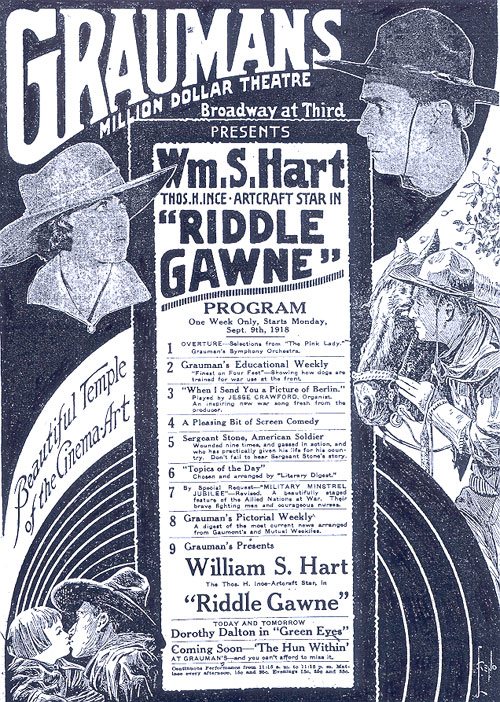
  RIDDLE GAWNE (1918 Paramount-Artcraft) Approx. 10 minutes RIDDLE GAWNE (1918 Paramount-Artcraft) Approx. 10 minutes
Sadly, only a 10 minute section of what appears to be an outstanding William S. Hart western survives today. Basic plot has Hart vowing vengeance on the man who killed his brother and ran away with his faithless wife. Lon Chaney, in a rare western role, is the man Hart is seeking.
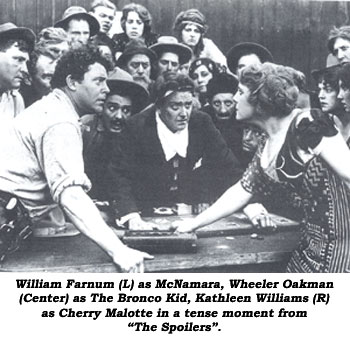    THE SPOILERS (1914 Selig-Polyscope) 83 minutes THE SPOILERS (1914 Selig-Polyscope) 83 minutes
To date Rex Beach’s novel has been filmed five times (1914, 1923, 1930, 1942, 1955). The original was a smash success starring William Farnum and Tom Santschi. It is the fight between the two men in the final reel that gives this original its enduring fame. The fight is real. At the start Santschi struck Farnum so hard it broke his nose. Farnum, convinced Santschi hit him on purpose, waded in. They went at it full force and each wound up in the hospital. However, upon viewing, over 90 years later, you find the on-screen fight only lasts a couple of minutes and, in retrospect, is overrated compared to, say, the Wayne/Scott battle in ‘42. It’s the reality that’s given this version its rep to become Selig’s most successful film. This version is also much closer to Rex Beach’s original story. The plot for the Wayne/Scott version was greatly altered to make it a vehicle for Marlene Dietrich as Cherry Malotte (played here by Kathleen Williams).
   THE TWO FISTER (1927 Universal) 20 minutes THE TWO FISTER (1927 Universal) 20 minutes
A dying father (Howard Davies implores his daughter (Elsa Benham) to marry Norbert Myles not realizing Myles is the secret outlaw leader who robbed and shot him. However, Elsa is in love with Mountie Edmund Cobb who straightens it all out in a furious action-packed final 10 minutes. Even at this early stage, the directorial talent of William Wyler is evident. By the ‘30s and ‘40s he was one of Hollywood’s top directors, winning Academy Awards for “Mrs. Miniver” (‘42), “The Best Years of Our Lives” (‘46) and “Ben-Hur” (‘59).
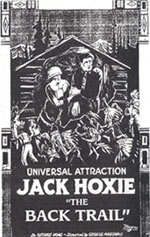   BACK TRAIL (1924 Universal) 47 minutes BACK TRAIL (1924 Universal) 47 minutes
Shell-shocked World War I veteran Jack Hoxie enters a sort of cowboy Cotton Club where devious gambler Claude Payton convinces him he has committed several crimes in the past, inducing Jack to break his father’s will so Payton can manipulate him to gain possession of the ranch of his foster sister, Eugenia Gilbert. Working with Payton in his tricky plot are Gilbert’s foreman Billy Lester and rustler Pat Harmon. With the aid of a mysterious tramp who is always lurking about (Jack’s real life half-brother, Al Hoxie—oddly billed here under his real name Alton Stone), Jack regains his memory in time to foil the crooks. Standard grab-the-ranch-from-the-girl plot with a few unique twists. Nicely filmed in the Alabama Hills of Lone Pine.
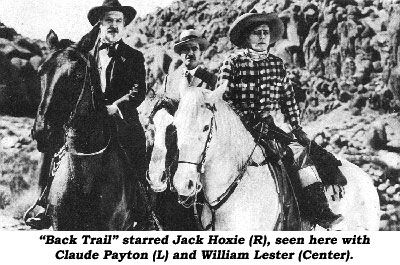
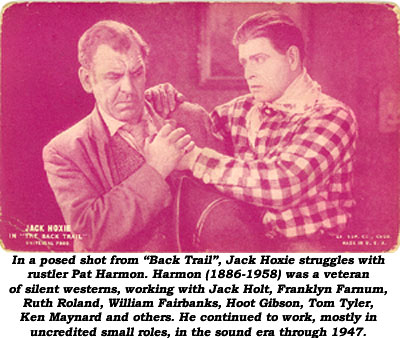
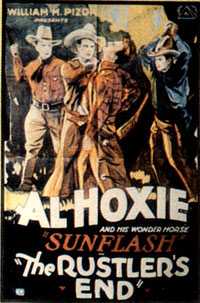    RUSTLER’S END (1928 Krelbar/Collwyn) 38 min. RUSTLER’S END (1928 Krelbar/Collwyn) 38 min.
RUSTLER’S END concluded Al Hoxie’s career as a star, it was the final film in his Krelbar/Collwyn series produced by William M. Pizor and directed by Robert J. Horner. There’s plenty of action as outlaw Bill Nestel, in revenge for Texas Ranger Al once locking him up, robs and kills Al’s brother (Herbert Walters) and captures Al’s girl Betty Gates.
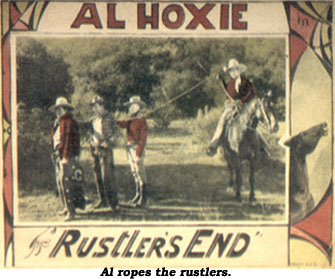
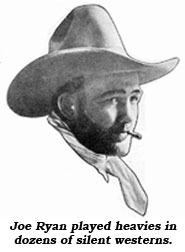   PIRATES OF THE PLAINS (1914 Colorado Motion Picture Co.) 36 minutes PIRATES OF THE PLAINS (1914 Colorado Motion Picture Co.) 36 minutes
The first film made by the Colorado Motion Picture Company is nicely photographed for an independent in 1914; a bit melodramatic, but—hey—it was 1914. Our hero Jim is framed for being a horse rustler by his outlaw brother, Joe Ryan. Jim’s girl, Josephine West, exposes Joe and saves Jim. Top-billed Ryan (1887-1944) was born in Wyoming, worked on ranches and wild west shows and began his movie career with this film. He then appeared in several Tom Mix one-reelers at Selig in 1917 and became one of the silent western’s best heavies.
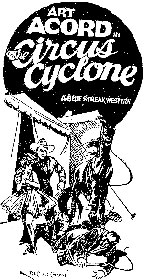   CIRCUS CYCLONE (1925 Universal) 8 minutes CIRCUS CYCLONE (1925 Universal) 8 minutes
Art Acord was a major western star at Universal from 1919-1922, but he was always in and out of trouble, often due to his drinking. Art totaled his car in June ‘22, reportedly as a result of drinking. He suffered a broken left leg and a fractured skull which required a lengthy period of recuperation. Universal had planned to star Art in a series of lumberjack two reelers but that was reassigned to Roy Stewart. Art returned to work in October ‘22 for filming of the 18 chapter OREGON TRAIL serial. Fed up with delays on the serial due to Art’s boozing, his contract was dropped. In late ‘23 Art and his OREGON TRAIL co-star—now also his lover—Louise Lorraine—headed for South America to make personal appearances. Both he and Louise were sued for divorce by their respective spouses in early ‘24. Returning to the States in late ‘24, Art made four cheapo films for Phil Goldstone Productions released through Truart. Hoping he had changed his ways, Universal took another chance on Art with a series of features, the first of which was CIRCUS CYCLONE. Unfortunately, only eight action-packed minutes of what looks like it might have been a hell of a picture has survived (found in Australia in ‘91). Plot has Art winning a talented circus horse in a boxing match with circus owner Albert J. Smith. Determined to get the horse back, Smith threatens to fire the horse’s former owner, Nancy Deaver, and her father, Popo the Clown. Smith eventually implicates Popo of robbing a bank. In the final surviving 8 minutes, Art learns of the plot and a wild chase ensues.
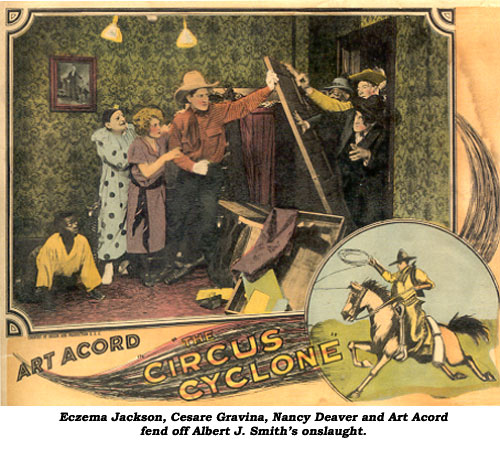
 LEGAL ADVICE (1916 Selig) 11½ minutes LEGAL ADVICE (1916 Selig) 11½ minutes
Tom Mix and his pals are infatuated with the town’s new lady lawyer (Victoria Forde) so Tom purposely gets jailed to make time with her. Tom’s Selig films were virtually one-reel western comedies.
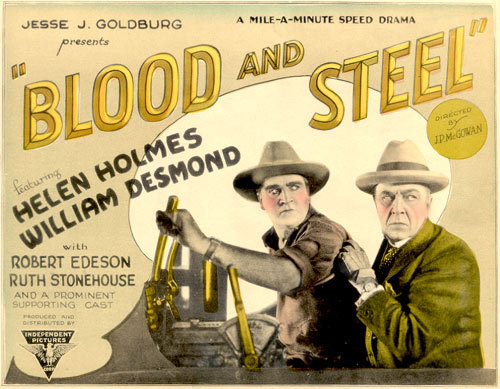
  BLOOD AND STEEL (1925 Independent Pictures Corp.) BLOOD AND STEEL (1925 Independent Pictures Corp.)
Blending both railroad and western elements, William Desmond is a tough construction engineer hired by General Manager Robert Edeson to complete on time a branch extension of Edeson’s railroad line. Mack V. Wright is overseer on the job for Edeson but is secretly working with construction boss Albert J. Smith to delay completion of the line so a rival can gain possession when Edeson loses his franchise. Edeson’s daughter, Helen Holmes, is at first smitten with Desmond but the engineer’s sternness with the workmen makes Helen think badly of him. Naturally, Desmond accomplishes his mission against all odds and wins Helen’s love. Incidentally, it is Helen who saves the day at the climax with the impending danger of an onrushing runaway train by throwing a switch avoiding a two-train collision. Muscular, square-jawed Dublin, Ireland, born Desmond was raised in New York and was a veteran of the theatrical stage and vaudeville before entering films in 1915. By the mid ‘20s he reached the pinnacle of his success as a virile action hero of outdoor dramas and 10 silent serials. Helen Holmes of Louisville, KY, came to Hollywood in 1912. She scored a huge success in 1914-‘15 as the original star of “The Hazards of Helen” Kalem serial. She starred in the first 48 chapters of the 119 episode series. In 1924 she co-starred with Desmond in the classic RIDDLE RIDER 15 chapter Universal serial. No doubt BLOOD AND STEEL director J. P. McGowan sought to cash in on their association as well as Holmes’ association with railroad serials. Multi-talented writer/film editor/assistant director/actor/director Mack
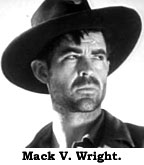 V. Wright (1895-1963) came out of Princeton, IN, to enter films in various capacities circa 1915. Later, in the sound era, he directed John Wayne B-westerns for Warner Bros. and several Gene Autry and Three Mesquiteers entries at Republic in the ‘30s. He also directed (or co-directed serials like ROBINSON CRUSOE OF CLIPPER ISLAND (‘36), VIGILANTES ARE COMING (‘36), GREAT ADVENTURES OF WILD BILL HICKOK (‘38) and SEA HOUND (‘47). V. Wright (1895-1963) came out of Princeton, IN, to enter films in various capacities circa 1915. Later, in the sound era, he directed John Wayne B-westerns for Warner Bros. and several Gene Autry and Three Mesquiteers entries at Republic in the ‘30s. He also directed (or co-directed serials like ROBINSON CRUSOE OF CLIPPER ISLAND (‘36), VIGILANTES ARE COMING (‘36), GREAT ADVENTURES OF WILD BILL HICKOK (‘38) and SEA HOUND (‘47).
   100% NERVE (1923 Pathé) 25 minutes 100% NERVE (1923 Pathé) 25 minutes
Undercover Texas Ranger Leo Maloney goes to work as a ranch hand for Fred Burns and daughter Pauline Curley and catches their former foreman Bud Osborne as a rustler. Very nicely directed by Ford Beebe (who also co-scripted with Maloney).
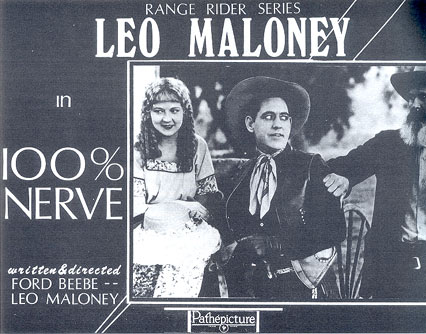
  VANISHING HERD (1928 Pathé) 3 minutes VANISHING HERD (1928 Pathé) 3 minutes
This brief three minute clip is the only known surviving footage of Don Coleman, obviously edited from a full length film, likely BOSS OF RUSTLER’S ROOST.
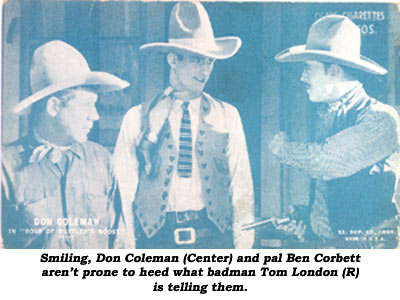
  DESERT OF THE LOST (1927 Pathé) 58 minutes DESERT OF THE LOST (1927 Pathé) 58 minutes
Wally Wales turns fugitive and flees to Mexico after shooting a man in self-defense. South of the border he falls in love with Peggy Montgomery, the daughter of slovenly cantina operator William Dyer who sells fake gold mine maps and is trying to force Peggy to marry half-Chinese outlaw Richard Neill. Wally intercedes, rescues her and captures the bandits. A detective trailing Wally throughout the picture (Edward Cecil) eventually catches up to Wally and…surprise, surprise…announces the charges against him have been dropped. Directed by Richard Thorpe who began as an actor in 1921, switched to directing in ‘23 and became a prolific MGM director from the ‘30s through the ‘50s (TARZAN ESCAPES, VOICE OF BUGLE ANN, TARZAN FINDS A SON, THIN MAN GOES HOME, CHALLENGE TO LASSIE, A DATE WITH JUDY, VENGEANCE VALLEY, CARBINE WILLIAMS, IVANHOE, JAILHOUSE ROCK, LAST CHALLENGE, etc.)
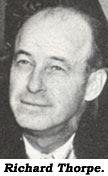 Johnny Sheffield, Boy in three Tarzan films Thorpe directed at MGM, told us Thorpe was “a clam, friendly guy—I never saw him get excited. He knew his business. He was easy going but always in charge. He was fast shootin’ but I felt he knew what he was doing. However, MGM had a policy to get a master-shot for everything. Thorpe always seemed to be fighting MGM and their policies about masters, which were strictly for the cutting room. He didn’t feel he needed them for every scene. He was very good with animals. Some of our directors had to have things a certain way with Cheeta—and elephants—but you can’t always get that. He had the patience to wait. Dick smoked a pipe and always had a twinkle in his eye.” Johnny Sheffield, Boy in three Tarzan films Thorpe directed at MGM, told us Thorpe was “a clam, friendly guy—I never saw him get excited. He knew his business. He was easy going but always in charge. He was fast shootin’ but I felt he knew what he was doing. However, MGM had a policy to get a master-shot for everything. Thorpe always seemed to be fighting MGM and their policies about masters, which were strictly for the cutting room. He didn’t feel he needed them for every scene. He was very good with animals. Some of our directors had to have things a certain way with Cheeta—and elephants—but you can’t always get that. He had the patience to wait. Dick smoked a pipe and always had a twinkle in his eye.”
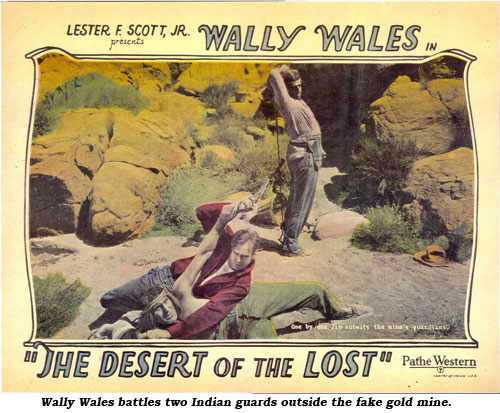
  PONY EXPRESS (1925 Paramount) 62 minutes PONY EXPRESS (1925 Paramount) 62 minutes
Aspiring to the greatness and success of THE COVERED WAGON, Paramount assigned James Cruze to helm another hunk of western history, the Pony Express. Unfortunately, the end result was nothing more than a B-western in A-trappings with the hackneyed plot elements interfering with the historical drama. Often compared to Cruzes’ COVERED WAGON or John Ford’s IRON HORSE, PONY EXPRESS pales in its lack of sweep and disappoints in its static plot of ambitious Senator Al Hart and his Knights of the Golden Circle who want to make California a separate empire with Hart on the throne. To do this he must slow down the progress of the Pony Express and prevent the news of Abraham Lincoln’s election from reaching California. Assisting him are henchman George Bancroft and half-breed Frank Lackteen. Opposing Hart is gunslinging gambler Ricardo Cortez who joins the pony riders. Complicating matters is the sub-plot of Ricardo’s romance with Bancroft’s daughter Betty Compson. Watch for Toby Wing as an endangered child. By the mid-‘30s Wing became one of the most celebrated chorus girls in Hollywood.
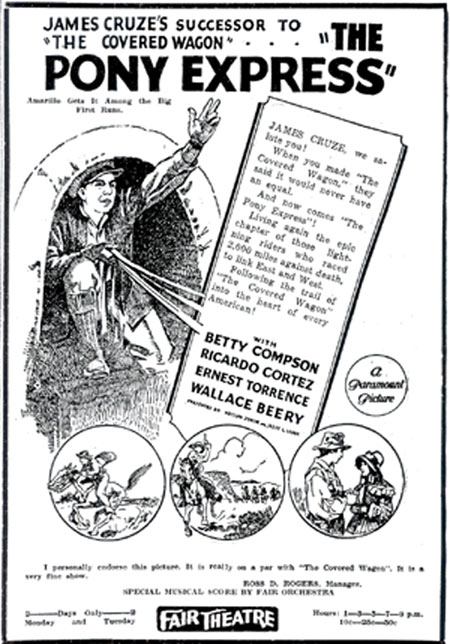
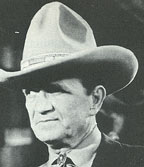   DESERT RAT (1919 Canyon Pictures) 23 minutes DESERT RAT (1919 Canyon Pictures) 23 minutes
In 1918 Franklyn Farnum (real name William Smith—no relation to William or Dustin Farnum) contracted to star in 26 two reelers and a serial (VANISHING TRIALS ‘20) for Canyon Films. Several of these co-star a cowboy who would eventually far surpass Farnum in popularity—Buck Jones. After striking gold, prospector Farnum and his Indian friend Standing Bear (Jones) hit the gambling den of Oasis run by thieving Vester Pegg. To get Farnum’s gold, Pegg’s girl, dance hall queen Lola Maxim, tricks Franklyn into marriage. Farnum learns he has been duped just as an old flame arrives. (Aren’t these film coincidences wonderful?) When Pegg makes advances on the girl, Lola turns her wrath on Pegg, but Farnum is blamed for his murder. It’s up to Buck Jones to save the day.
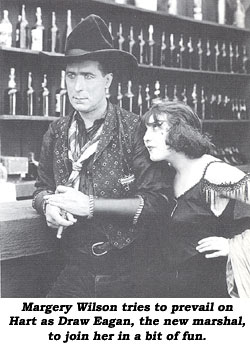   THE RETURN OF DRAW EAGAN (1916 Triangle) 50 minutes THE RETURN OF DRAW EAGAN (1916 Triangle) 50 minutes
Another in the many William S. Hart good-badman portrayals. With a price on his head, outlaw Draw Eagan (Hart) and one of his gang (cowardly, braggart Robert McKim) escape from a burning cabin, leaving the impression he is dead. Arriving in Yellow Dog, a town where the bad element has been running things, the reform element sees in the tough Hart a chance to clean up the town by appointing him city marshal—not realizing he is the infamous Draw Eagan. Hart accepts, falling for town cutie Margery Wilson and vowing to himself to go straight. But Marshal Hart incites the wrath of dance hall queen Louise Glaum who vows to expose Hart’s past when she learns who he really is from the devious McKim who has just arrived in Yellow Dog. Cowboy cancer alert: Hart smokes up a storm.
top of page
Posted 3/18/08
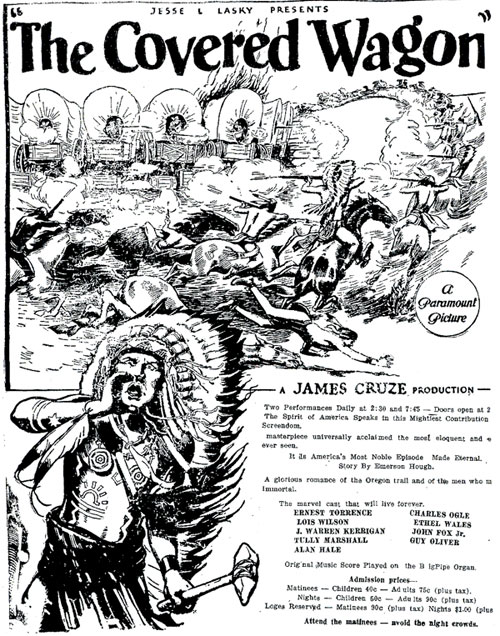
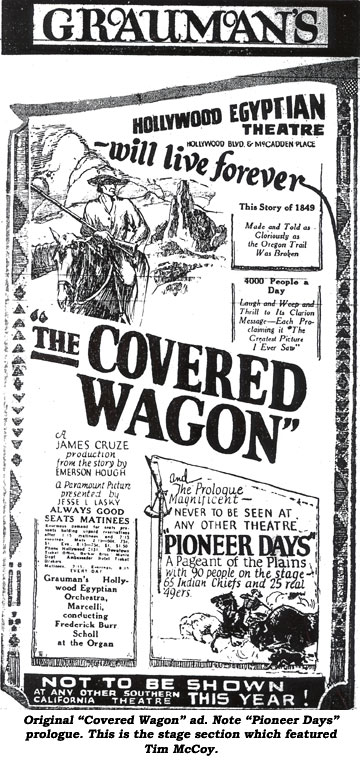
  THE COVERED WAGON (1923 Paramount) 97 minutes THE COVERED WAGON (1923 Paramount) 97 minutes
In 1923 the western was in the doldrums, only 50 programmer-type westerns were made that year, but due to the success of THE COVERED WAGON that number nearly tripled in 1924, and the lowly number of 50 was never seen again until 1959. The first western epic, THE COVERED WAGON astonished audiences with its grandeur, but today pales in comparison with later epics, therefore should be viewed with a 1923 mindset. Because it was such a huge success at the time, the legend of the film has people believing it was a great film. It was not. Today THE COVERED WAGON seems almost pedestrian, but at the time the sheer size and splendor of the picture was overwhelming to 1923 audiences. But watching it today its 98 minutes seem interminably longer than John Ford’s IRON HORSE a year later which was 2 hours and 12 minutes. Theme in THE COVERED WAGON is more important than plot. The 2,000 mile wagon trek in 1848 from Kansas City to Oregon—and on to California’s gold fields—remains foremost in the film, but the romantic difficulties of stars J. Warren Kerrigan/Lois Wilson/Alan Hale remain a standard B-soap opera plot. Also the film really hits a logjam when scout Jim Bridger (played by Tully Marshall) arrives and the plot veers off into his forgetfulness due to lack of drinkin’ liquor. Although references are made to historic figures such as Jim Bridger, Abraham Lincoln and Brigham Young, the film is void of the vital, dramatic sweep of opening up new frontiers as was conveyed a year later in Ford’s THE IRON HORSE. Additionally, James Cruze wasn’t enough of a creative director to sustain suspense or to stage exciting action sequences. Simply compare Ford’s Indian battle in THE IRON HORSE with the one in THE COVERED WAGON.
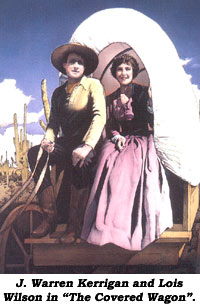 Star J. Warren Kerrigan (1879-1947), born in Louisville, KY, got his start as a male model and in vaudeville. The 6 foot tall handsome star made his film debut in 1909 at Essanay in Chicago. Upon organization of the American Film Company in Chicago he was their major star in hundreds of one reel westerns from 1911-1913 (mostly directed by Allan Dwan). Enticed to move to Universal in 1914 he became the highest paid actor of the time, but his career was destroyed by his unpatriotically refusing to enlist in the service during WWI. “I think they should take the great mass of men who aren’t good for anything else, are good only for the lower grades of work,” he stated. Termed a “slacker” by the press, his career was sliding into oblivion with low budget independent releases until director James Cruze chose him to co-star with Kerrigan’s former Universal leading lady Lois Wilson in THE COVERED WAGON. The film briefly revitalized his career, but after 1924’s CAPTAIN BLOOD he retired to Balboa, investing his money in real estate. He died at 68 of bronchial pneumonia. Filmed mostly on a 200,000 acre ranch in the Snake Valley of Nevada, but also utilizing some Utah locations and gold camp scenes in Bishop, California, and budgeted at $500,000, the final negative cost of THE COVERED WAGON was $782,000. But a huge hit, it eventually grossed $3.8 million. Knowledgeable in Indian lore and sign language, 31 year old Colonel Tim McCoy resigned his position as adjutant general of Wyoming with the U.S. Cavalry to become technical advisor on the picture and to bring 500 Arapahoes and Shoshonis to Milford, Utah, as extras in the picture. When the film was completed, for an on-stage prologue to the picture, McCoy brought 35 Indians to Grauman’s Egyptian Theatre. An immense success, McCoy’s Indian sign-language prologue played for four months at Grauman’s, then traveled to England with the picture for 7 months. Star J. Warren Kerrigan (1879-1947), born in Louisville, KY, got his start as a male model and in vaudeville. The 6 foot tall handsome star made his film debut in 1909 at Essanay in Chicago. Upon organization of the American Film Company in Chicago he was their major star in hundreds of one reel westerns from 1911-1913 (mostly directed by Allan Dwan). Enticed to move to Universal in 1914 he became the highest paid actor of the time, but his career was destroyed by his unpatriotically refusing to enlist in the service during WWI. “I think they should take the great mass of men who aren’t good for anything else, are good only for the lower grades of work,” he stated. Termed a “slacker” by the press, his career was sliding into oblivion with low budget independent releases until director James Cruze chose him to co-star with Kerrigan’s former Universal leading lady Lois Wilson in THE COVERED WAGON. The film briefly revitalized his career, but after 1924’s CAPTAIN BLOOD he retired to Balboa, investing his money in real estate. He died at 68 of bronchial pneumonia. Filmed mostly on a 200,000 acre ranch in the Snake Valley of Nevada, but also utilizing some Utah locations and gold camp scenes in Bishop, California, and budgeted at $500,000, the final negative cost of THE COVERED WAGON was $782,000. But a huge hit, it eventually grossed $3.8 million. Knowledgeable in Indian lore and sign language, 31 year old Colonel Tim McCoy resigned his position as adjutant general of Wyoming with the U.S. Cavalry to become technical advisor on the picture and to bring 500 Arapahoes and Shoshonis to Milford, Utah, as extras in the picture. When the film was completed, for an on-stage prologue to the picture, McCoy brought 35 Indians to Grauman’s Egyptian Theatre. An immense success, McCoy’s Indian sign-language prologue played for four months at Grauman’s, then traveled to England with the picture for 7 months.
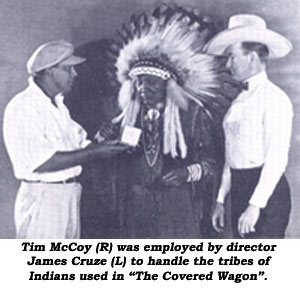
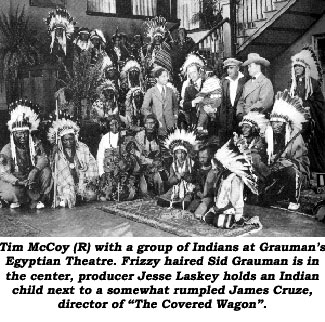
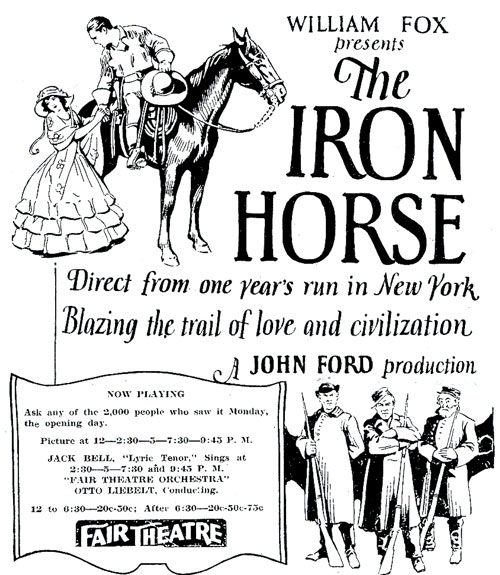
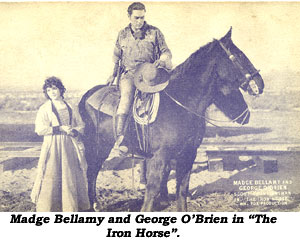     IRON HORSE (1924 Fox) 132 minutes IRON HORSE (1924 Fox) 132 minutes
Still one of the most majestic westerns of any period, John Ford’s 50th film is a trendsetting epic filled with splendidly fluid camera work, classic scenes for the time period and brilliant editing. Although the overall theme, the building of the first American transcontinental railroad from 1862 to 1869, is epic in sweep, the central theme of a man hunting his father’s murderers was certainly right out of the B-western playbook. Weakest sections of the over two hour film are the ever present broad slapstick Irish humor interludes for which Ford was known. As President Lincoln (Charles Edward Bull) signs a bill to begin the transcontinental railroad, young Davy (Winston Miller) says goodbye to his childhood friend, Miriam (Peggy Cartwright) as he and his father (James Gordon) set out with the railroad in mind. After spotting a passage through the mountains (Beale’s Cut in reality), Gordon is brutally killed by Fred Kohler, a two fingered white renegade (Ford cleverly incorporates Fred Kohler’s actual deformity into the plot) leader of a band of Indians. A decade later finds Davy (George O’Brien) a pony express rider who re-enters the life of Miriam (Madge Bellamy) only to find she is engaged to eastern railroad engineer Cyril Chadwick, secretly working with Kohler who now in the guise of a large land owner, wants the railroad to go through his land alone for his own profit. To help Miriam’s father (Will Walling) who is building the Union Pacific leg of the railroad, O’Brien tries to show Chadwick the pass his father located years ago which would shorten the railroad by 200 miles, but the nefarious Chadwick tries—unsuccessfully—to kill O’Brien at the pass. Returning, O’Brien beats Chadwick to a pulp, but in so doing loses the love and respect of Bellamy. O’Brien and his pal, J. Farrell McDonald, leave and join the other railroad, the Central Pacific, which is working its way westward to join the Union Pacific. In a wild finish during a large scale Indian raid on the railroad, led by Kohler once again masquerading as a renegade, O’Brien learns it was Kohler who murdered his father and kills the renegade in hand to hand combat. The two railroads are historically joined at Promentory Point, Utah, and O’Brien and Bellamy are also romantically rejoined. In THE FILMING OF THE WEST, Jon Tuska observed, “Ford’s intent was to show how men and women, sinful, sentimental, cowardly, raucous, human beings of all different races, nationalities, and backgrounds were brought together and transformed, forced to rise above themselves in service to a cause that in consequence exceeded anything in their personal lives. ‘The Iron Horse’ celebrates the joy of accomplishment that once made America the land of promise. (The film) is symbolized by the small dog that cradles its head on his fallen Indian master’s chest; young Davy at the grave of his father—or J. Farrell MacDonald offering a coolie a chaw of tobacco. ‘The Iron Horse’ is infused with a spirit of human compassion that not only exceeds the minority of individual relationships and the majority of belonging to an epic event, but affirms a fundamental solidarity at the base of the human enterprise.” Budgeted at $280,000 and partly filmed in Utah with townsites build near Dodge Flats, Nevada, THE IRON HORSE was a monumental organizational undertaking for Ford, a man still in his 20s. Five thousand extras were employed as railway workers, Cavalry, trail drovers, Chinese laborers and Indians. 2,800 horses, 1,300 buffalo and 10,000 head of cattle were also utilized. The original trains from Promentory Point were also brought into use for the final sequence—the Jupiter from the Central Pacific and #116 from the Union Pacific.
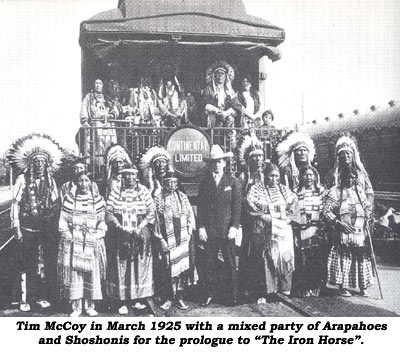
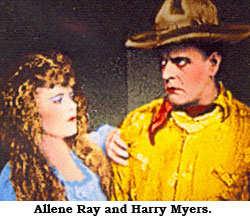   TRAIL’S END (1919 Border Pictures) 23 minutes TRAIL’S END (1919 Border Pictures) 23 minutes
Best known as a writer/director/actor in short comedies from 1908 to 1919, for whatever reason Harry Myers (1882-1938) decided to try his luck starring in a serial for Arrow in 1919—THE MASKED RIDER. During the same period he also starred in a handful of two-reel westerns co-starring Pathé-serial-queen-to-be, Allene Ray. Plot has Myers returning west after four years in college and becoming ga-ga (displaying his comedic side) over beautiful but blind Allene. Trouble arises when Harry learns the murderous rustler he seeks is Allene’s father.
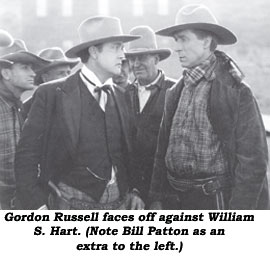    THREE WORD BRAND (1921 Artcraft/Paramount) 55 minutes THREE WORD BRAND (1921 Artcraft/Paramount) 55 minutes
William S. Hart plays three roles in this drama about crooked politicians trying to secure water rights in a Utah valley. After their father (Hart in role #1) is killed in an Indian raid, young twin brothers Ben and Paul become separated when Paul is adopted from an orphanage. Grown to manhood, one brother, Ben—known as Three Word Brand due to his paucity of speech—(Hart in role #2) is half owner of the Bar 7 with S. J. Bingham whose sister Jane Novak has just arrived out west. With land speculator Herschel Mayall, Hart and Bingham’s neighboring rancher,
Gordon Russell, frames Bingham on a trumped up murder charge hoping Hart will put up a battle so they can arrest him and thereby gain control of the Bar 7 which they need to implement their devious water rights bill now before the new governor; a bill that would break the valley ranchers. As only in a movie coincidence, the new governor is Paul (Hart #3). Concerned over the water rights, he arrives in the valley on an exploratory “hunting trip”. Discovering his brother is the governor, Ben secretly takes his brother’s place in the capitol where he quickly signs a pardon for his partner and vetoes the costly water bill. Dismayed, the crooks attack Ben’s ranch, wounding the governor but Ben arrives in time to save his brother’s life and the two are once again reunited. Under Lambert Hillyer’s direction, the plot-heavy story never lags, offering Hart a chance to display his acting ability in three different guises.
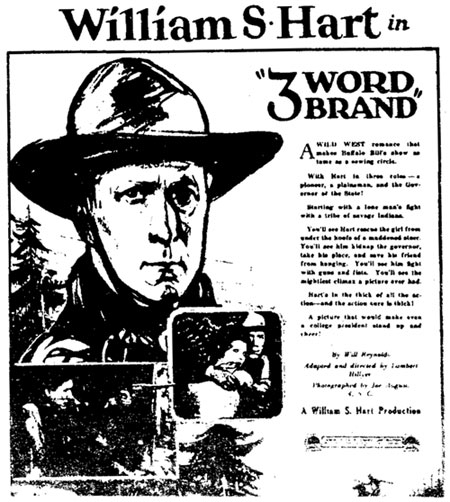
  THUNDERING THROUGH (1925 Artclass) 13 minutes THUNDERING THROUGH (1925 Artclass) 13 minutes
In order to meet pretty ranch owner Jean Arthur, Buddy Roosevelt takes a job on the neighboring ranch but runs afoul of Jean’s foreman Lew Meehan. This 13 minute edit of THUNDERING THROUGH is entitled RIDING RIVALS.
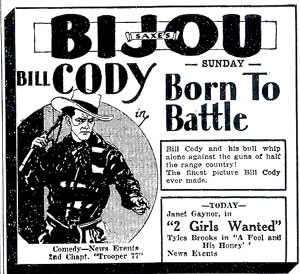    BORN TO BATTLE (1927 Pathé) 46 minutes BORN TO BATTLE (1927 Pathé) 46 minutes
Stories about feuding clans were a Hollywood favorite and here’s a fine example. Bill Cody portrays the son of hateful, battered old Nora Cecil who hates her neighbors, J. P. Lockney and his daughter, pert Barbara Luddy, believing Lockney killed her husband. Defying their parents, Cody and Luddy are romantically involved therefore Cody wants no part of the feud, so Cecil tries to enlist the support of her other three loutish, no-count sons, Olin Francis, Frank McGlynn, Ralph Yearsley. However, for selfish reasons of his own, Cody’s vicious uncle, Sheldon Lewis, and his gun-rannies Lew Meehan and Sailor Sharkey, plot to carry on the feud. Lockney, learning it was Lewis who actually gunned his own brother—Cecil’s husband—confronts Lewis who then shoots him and attempts to throw blame on Cody. Alvin J. Neitz (aka Alan James) directs with a sure hand giving the picture a fast, exciting flair. Incidentally, long before Lash LaRue or Whip Wilson, Cody uses a bullwhip in BORN TO BATTLE to dispense justice. The Canadian born Cody had served an apprenticeship as a stuntman in the early ‘20s and was already 34 when he signed with Jesse Goldburg’s IPC for a starring series. In 1927 Cody formed his own production company and arranged for release of his films through the prestigious Pathé who maintained an excellent marketing system. Unfortunately, he and his horse Ranger made only four westerns before Pathé ran into financial troubles with the coming of sound and abandoned production and distribution of westerns in early 1928. When Cody tried to regain his popularity with sound westerns in 1931 he was already 43 and could only find a home in bottom-of-the-barrel B-westerns at Monogram and Spectrum. Also, according to sources such as director Oliver Drake, Cody drank a bit too much and struggled with dialogue delivery. His glory days were over and he made his final starrers in ‘35, although he managed to find bit parts in a few films through ‘48. Cody died of alkalosis at 57 on January 24, 1948.
 THE AVENGER (1924 Aywon) 57 minutes THE AVENGER (1924 Aywon) 57 minutes
Big Boy Williams stars in this meandering, humdrum and shopworn story about a crooked real estate agent (Fred Maletesta) trying to force heroine Kathleen Collins into marrying him. Nearly twirling his mustache in Oil Can Harry fashion and mad because she rejects his advances, Maletesta frames Collins’ kid brother for theft of funds and threatens the girl to foreclose on her mortgage. For help, Collins turns to neighboring ranch owner Williams whom she mistakenly believes to be only a ranch hand. The one bright spot is an outrageous scene in which Big holds Malestesta’s head between his knees while he spanks the evil villain.
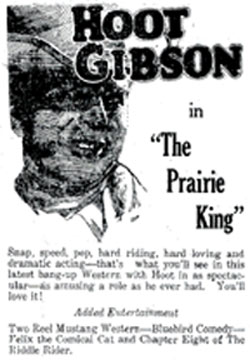    PRAIRIE KING (1927 Universal) 57 minutes PRAIRIE KING (1927 Universal) 57 minutes
Three claimants to deceased old miner Abner’s valuable gold strike gather in Noches—all who have earlier shown him some kindness—pretty young Barbara Worth, Hoot Gibson and crooked Albert Priscoe who once staked ol’ Abner. However, there’s one mysterious condition to Abner’s will which lawyer Robert Homans is not allowed to reveal. Arriving at the mine, Hoot and his pal Charles “Pop” Sellon (who, at times, must be “channeling” Andy Clyde) find themselves at odds with, and in love with, Barbara Worth and her aunt, Rosa Gone. One of director B. Reeves “Breezy” Eason’s earliest directorial efforts, PRAIRIE KING is lighthearted enjoyment that culminates at a fiesta with an old fashioned el chuchillo knife fight.
  TWISTED TRAILS (1916 Selig) 34 minutes TWISTED TRAILS (1916 Selig) 34 minutes
Simplistic Selig three-reeler has Tom Mix getting mixed up with Sid Jordan’s rustlers and being framed for he and rascally sheriff Pat Chrisman’s thievin’ ways. Suddenly the story changes to focus on Bessie Eyton who Tom must rescue from the clutches of an unwanted suitor, gambler Will Machin. Unfortunately, due to the outmoded camerawork and direction, most of Tom’s Selig westerns seem quite dated by later standards and must be viewed with the time period in which they were made solidly in mind. TWISTED TRAILS makes excellent use of Beale’s Cut.
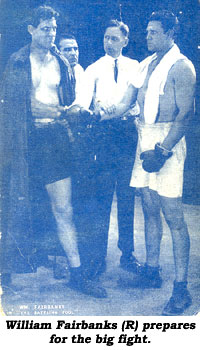  THE BATTLING FOOL (1924 Perfection) 58 minutes THE BATTLING FOOL (1924 Perfection) 58 minutes
The man who became William Fairbanks was born Carl Ullman May 24, 1893, in St. Louis, Missouri. After attending St. Louis Military Academy where he learned to ride, he drifted west picking up odd jobs as a cowpuncher and rodeo rider before entering films circa 1916. He was just gaining a foothold when WWI interrupted his career in 1917. Returning in 1920 he signed with producer Phil Goldstone for Pioneer Films. This is when he became William Fairbanks—with no relationship to the famous acting family. Another series of westerns for Ben Wilson’s Arrow productions followed in ‘22-‘23. After a few independent features, BATTLING FOOL included, Fairbanks re-signed with Goldstone for another series in ‘24. From ‘25-‘28 his films were mostly non-western oriented action pictures. Then he disappeared from the Hollywood scene, leaving little if any trace except for a WPA document bearing his name in 1936. (The WPA was a relief measure established by the government in 1935 offering work to the unemployed for a variety of public works projects.) Ullman/Fairbanks died unknown April 1, 1945, in L.A. of lobar pneumonia. BATTLING FOOL is only one of two surviving films starring Fairbanks. Not truly a western, this small-town melodrama finds Bill a small town prizefighter who goes against his minister-father’s wishes, as well as those of his girlfriend’s father, that he not engage in such a lowlife roughhouse sport. Winning $100 in a local exhibition boxing match Bill leaves town to pursue a fight career not realizing the girl he loves, Eva Novak, the mayor’s daughter, was crippled in a melee following the local match. Returning well-known after six months he discovers what has happened to Eva and now must win the biggest fight of his career to pay for an operation so his girl can walk again.
 ACROSS THE PLAINS (1928 Associated Independent Producers) 37 minutes ACROSS THE PLAINS (1928 Associated Independent Producers) 37 minutes
Bottom-of-the-barrel silent written and directed by Robert J. Horner starring Pawnee Bill Jr.—Horner’s alias for Ted Wells. Down on her luck Ione Reed, the girl Wells is sweet on, gets a job as a waitress in a hash house run by saloon owner Martha Barclay and her partner Cliff Lyons. Reed wants Bill to reform and stop gambling but Bill encounters trouble when he guns cheating card-sharp Boris Bullock, then must contend with Bullock’s pal, crooked new sheriff Jack Richardson who comes gunning for Bill. Richardson is over-the-moon hammy in his performance and the plot is a mite convoluted with very little action. Cowboy cancer alert: Our hero smokes while playing cards.
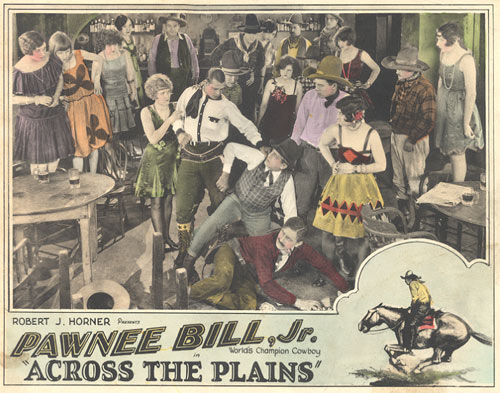
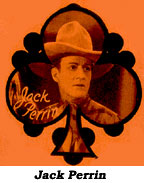   BORDER VENGEANCE (1925 Aywon) 46 minutes BORDER VENGEANCE (1925 Aywon) 46 minutes
Born in Three Rivers, Michigan, Jack Perrin moved with his family to California when he was six. Interested in acting, circa 1914-‘15 found him playing insignificant parts in Keystone Kop comedies. In 1919, following WWI, he began to find roles in westerns with Eddie Polo and Hoot Gibson. His big break came when he was chosen to star in Universal’s THE LION MAN serial in 1919. From ‘19 to ‘23 Jack starred in several Universal two reelers. He married one of his leading ladies, Josephine Hill, in 1920 (they later divorced in ‘37). From ‘23 to ‘26 Jack and his horse Starlight starred in westerns (like this one) for independent producer Harry Webb releasing through Arrow and Aywon. BORDER VENGEANCE finds Jack half-owner of a ranch with Bud Osborne who has a penchant for gambling. Jack befriends neighboring miner Hugh Saxon who believes his claim is worthless, but he’s told his eastern granddaughter (Josephine Hill) he’s struck a bonanza, and how she’s headed west believing Granpop is wealthy. And, unbeknownst to Saxon, actually he is, but sleazy gambling hall owner Tom London (billed under his real name Leonard Clapham) in cahoots with crooked assayer Jack Richardson is keeping that fact from Saxon. Injured in a mine accident, Saxon dies just as Hill arrives. London cheats Osborne out of his ranch and tries to swindle Hill out of the mine. But London goes too far when he tries to cut Richardson out of the crooked dealings and the assayer spills the beans to Perrin who saves the day for all. Involving story, but short on action til the final fisticuffs between Perrin and London, which is a doozy.
   DESERT GREED (1926 Goodwill) 50 minutes DESERT GREED (1926 Goodwill) 50 minutes
Troublebuster Texas Ranger Yakima Canutt befriends innocent Rose Blossom (Yep—that’s her name!) whose cruel stepfather Dick LaReno (he beats her with a bullwhip in one sadistic scene) has made a deal to marry Rose off to sleazy attorney Henry Hebert who secretly has discovered Rose is heiress to a small fortune back east in Chicago. Fairly routine til the last few minutes, then it’s Go Get ‘Em Yak!
top of page
Posted 2/26/08
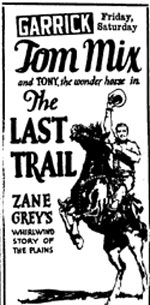     THE LAST TRAIL (1927 Fox) 55 minutes THE LAST TRAIL (1927 Fox) 55 minutes
THE LAST TRAIL, a whirlwind blend of furious Tom Mix action and comedic situations, starts with Tom rescuing Lee Shumway from marauding Indians and never lets up right on through the wild stagecoach race at the finale that threatens to rival the chariot race in BEN HUR. Paying scant attention to the Zane Grey novel from which it purportedly draws its inspiration, the tale has Tom entrusted with the care of Shumway’s young son, Jerry Madden, after Sheriff Shumway is killed by Frank Hagney’s outlaws. Leading lady Carmelita Geraghty helps Tom care for Madden as she and Tom fall in love. Tom, becoming sheriff, vows to bring to justice Shumway’s killer, but meanwhile must help Geraghty’s father win the express contract in the free-for-all stagecoach race against devious William Davidson who is secretly Hagney’s boss. Some great location work in the Alabama Hills of Lone Pine.
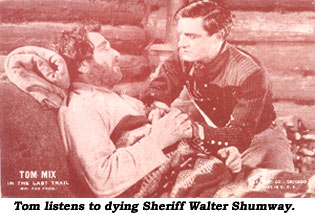 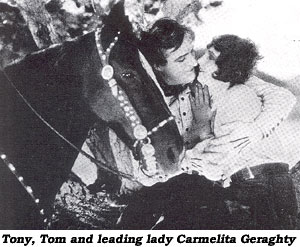
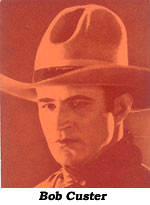  COVERED WAGON TRAILS (1930 Syndicate) 48 minutes COVERED WAGON TRAILS (1930 Syndicate) 48 minutes
Deputy Sheriff Bob Custer discovers the brother (Perry Murdock) of his girlfriend (Phyllis Bainbridge) is mixed up with border smugglers Marlin Cichy, Bud Osborne and Cliff Lyons. Uninspired direction from J. P. McGowan hampers the film’s enjoyability. Born Raymond Glenn in 1898 in Frankfort, KY, he studied Civil Engineering before heading west in 1922. After interviewing with J. J. Goldburg at FBO, Raymond Glenn was rechristened Bob Custer. “Those people already had the name Bob Custer picked out,” Bob told interviewer Ron Coons in ‘74, “Whoever signed the contract was to take that name. The name Custer was well known. There was also a Bill Cody and a Buddy Roosevelt—just anything they thought might catch on.” Bob’s first starrer at FBO was TRIGGER FINGERS in ‘24. From ‘24-‘27 his stern visage starred in some 24 westerns for FBO. He made a few non-westerns then hooked up with Syndicate and churned out 20 low-budget B-westerns on into the beginning of the talkie era, all but one under the direction of the debatably talented J. P. McGowan. A few more for Big 4, Reliable and a serial (LAW OF THE WILD) for Mascot ended Bob’s film career in ‘37. He returned to engineering, starting a construction business in the San Fernando Valley. Heart problems left Bob 4-F for WWII service, so he worked in shipyard accounting and timekeeping departments. After the war, he was an L.A. City inspector, street superintendent in Redondo Beach and a building inspector for Newport Beach and El Segundo. His life ended with a heart attack in Redondo Beach on December 28, 1974. (For a full interview with Bob Custer, read WESTERN CLIPPINGS #23.)
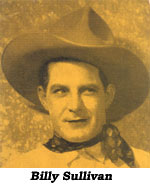   ONE PUNCH O’DAY (1926 Rayart) ONE PUNCH O’DAY (1926 Rayart)
The nephew of heavyweight champion John L. Sullivan, William Arthur Sullivan, born July 18, 1891, in Worcester, MA, entered movie-making in 1914 where he knocked around until Universal signed Billy Sullivan for a 1924-‘25 series of 16 two-reelers called “The Battling Cowboy Stories”. Unfortunately, none of these are available for viewing. Known, like his uncle, for his boxing prowess, Billy joined Rayart where he made a group of features from ‘25-‘27, about half of which were action-boxing pictures. In this one, after a brawl in a café, pugilist Sullivan comes west “in a hurry” where he’s mistaken by Charlotte Merriam and her father as an oilman. Against all odds, he learns oil drilling operations and brings the well in on time to save the day from the evil money lenders. * * After Sullivan left films in ‘36 he devoted himself to his home in Great Neck, NJ, where he died May 23, 1946.
  RIDIN’ MAD (1924 Arrow) 17 minutes RIDIN’ MAD (1924 Arrow) 17 minutes
RIDIN’ MAD was famous stuntman Yakima Canutt’s first starring feature, released through Arrow for Ben Wilson’s productions. Yak had been stunting and playing small roles since 1919 opposite Jack Hoxie, Neal Hart, Edmund Cobb and others. Writing in his autobiography, STUNT MAN (‘79), Yak recalled how “flustered” he became in his early acting scenes. “For a week or so before the starting date, I couldn’t sleep. I was scared to death. I would gladly have exchanged some of the intimate scenes for a single-handed fight with a grizzly bear. I was a wreck when I arrived on the set the morning we were to start shooting. When we stopped to eat, I was so tied with nerves that I went behind the Mission and lost my lunch. When we finished ‘Ridin’ Mad’ and it was cut and put together, I could hardly believe my eyes. For a quickie, it was a very good western. I didn’t care too much for my acting, but (Ben) Wilson and (director) Jacques Jaccard said I looked okay and would improve with experience.” Unfortunately, a full print of RIDIN’ MAD apparently did not survive and we’re left with a 1926 Pizor edit with sound narration by Bud Pollard. There’s plenty of real rodeo footage followed by some hard-to-follow plot (due to severe editing) but plenty of fast action as Yak catches some oil swindlers and killers of leading lady Lorraine Eason’s father.
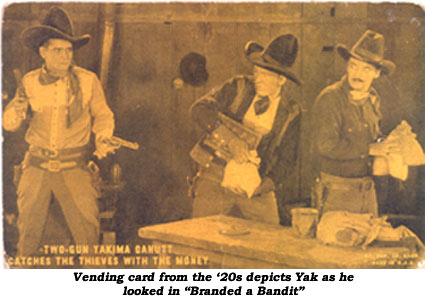
   BRANDED A BANDIT (1924 Arrow) 57 minutes BRANDED A BANDIT (1924 Arrow) 57 minutes
Discovering gold, Grandpa Judge Hamilton gives Yakima Canutt (dressed nearly as fancy as Tom Mix) a sample of the ore to take into town to show to Hamilton’s granddaughter, storekeeper Alys Murrell, but nasty Wilbur McGaugh and his gang rob and kill Hamilton, branding Yak as a bandit. It takes plenty of rough ridin’, wild stunts and fast shootin’ for Yak to prove his innocence. With an action packed delivery from director Paul Hurst, Yak really shows off the expert stuntwork that later so enhanced John Wayne’s early Lone Stars. In his 1979 autobiography, STUNT MAN, Yak wrote “In ‘Branded a Bandit’, directed by Paul Hurst, we went to Kernville. Paul, like me, loved action and this film was loaded with it. In one sequence I was doing a fight with the heavy on top of a bluff that overhung the river. We fought to the edge of the bluff and went into a clinch. The camera was reset across the river at water level. At that point, Cliff Lyons, a stunt man, came into the shot, doubling for the heavy. We overlapped the previous scene, fought to the edge of the bluff, went into a clinch and spun off, falling to the river below. We continued fighting and Cliff, who was a good stunt man but the world’s worst swimmer, had a big problem. We would fight a bit, then I would have to help him out of the river to keep him from drowning. Hurst finally got disgusted and stopped the cameras. ‘Give me those clothes,’ he ordered. ‘I’ll show you how to fight in the water.’ He changed into the double’s wet clothes, and ordered the cameraman to pan with us. ‘We’ll fight in mid-stream for a few feet,’ he told me, ‘then I’ll shove you under water and swim to that rocky point with you after me. You catch up as I get to that shelf. I’ll turn and swing at you, you duck, and the force of the swing will carry me into the water.’ ‘Then,’ I said, ‘I jump or dive back in and we fight some more, right?’ ‘Right.’ Paul was a good swimmer and we put on quite a fight. Paul pounded me under the water and headed for the rocky point. I kept very close to him as I had a plan to change the fall a bit. Just as Paul got on the ledge, I quickly climbed up on the rocks and grabbed him. Hanging on tight, I went backwards off the bluff. We hit the water and went under. When we surfaced Paul started to laugh, but I still carried on the fight. He got a bit of water in his lungs and began coughing, so I dragged him to shore. ‘Why did you grab me and do that Gilligan fall?’ he choked when he finally got his breath. ‘Well, Paul,’ I said, ‘I figured it would be better to do it that way than to have you ride me into a big splash!’ Paul enjoyed that prank as much as I did.”
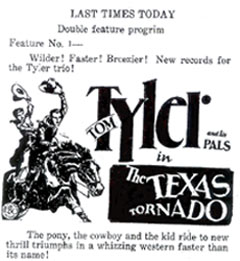     TEXAS TORNADO (1928 FBO) 40 minutes TEXAS TORNADO (1928 FBO) 40 minutes
Born Vincent Markowski in 1903 in Port Henry, NY, the skilled athlete who became Tom Tyler migrated west to Hollywood in 1924, soon signing a five year contract with FBO. What Tyler lacked in acting talent was more than made up for by his athletic daring stunts, some of the best to be seen in the silent era. FBO often teamed Tyler with the equally athletic youngster Frankie Darro. Found in Europe, although footage is missing, this rare Tyler has been restored as well as possible by Sinister Cinema. With newly discovered oil fields, Nora Lane and her kid brother, Frankie Darro, have until 3pm to renew a lease on their property or it will revert to slimy, crooked neighbor Jack Anthony. In a wild action sequence, Tyler arrives, delivering the dough to the bank in the nick of time. In a last ditch attempt to gain the rich oil leases, Anthony’s gang kidnaps young Darro but in another thrilling sequence, Tom rescues Frankie from a mountain cave hideout. And it gets even better during a hair-raising climax with Tom and Frankie suspended in a cable car miles above a deep canyon! Written and directed by Frank Howard Clark. Not to be missed! (Watch for former silent star Bob Reeves as one of Anthony’s henchmen.)
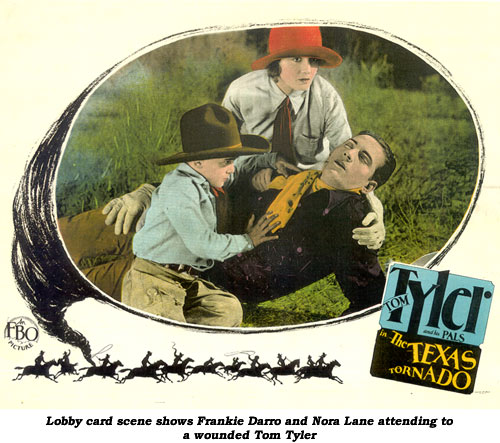
    THE COURAGE OF COLLINS (1927 Universal) 21 minutes THE COURAGE OF COLLINS (1927 Universal) 21 minutes
Edmund Cobb, a Canadian Mountie in plain clothes, is assigned to protect Helen Foster and her kid brother, Newton House, who are beset by claim jumpers led by Walter Shumway. Cobb triumphs against all odds under the more than able direction of Ray Taylor who adds puh-lenty to the classy style, suspense and pacing of this fast-action two reeler. Taylor (1888-1952) started as a stage actor and stage manager, then became an assistant director for John Ford before graduating to director himself. This is one of his earliest, quickly highlighting his talent behind the megaphone. As sound entered, Taylor became a prolific director of serials at Universal, and later, even a few at Republic and Columbia. As well, he helmed B-westerns with Buck Jones, Tex Ritter, Johnny Mack Brown, Lash LaRue, Eddie Dean and Whip Wilson.
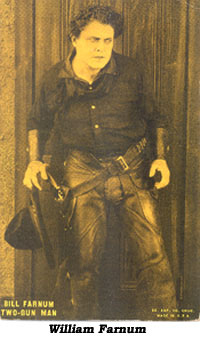   DRAG HARLAN (1920 Fox) 63 minutes DRAG HARLAN (1920 Fox) 63 minutes
Born in Boston, MA, on July 4, 1876, William Farnum began a stage career at 14. He toured in BEN HUR for nearly five years before coming to Hollywood in 1912. After his huge success in THE SPOILERS (‘14, Selig) Farnum was the highest paid actor in movies, ranking in popularity with William S. Hart and Douglas Fairbanks. Farnum joined Fox in 1915 where he became the studio’s biggest star, especially when he starred in their Zane Grey adaptations. The Fox westerns of this period concentrated more on plot and dramatics than did those of Universal, FBO, Arrow and others who favored wild action. Here, as notorious gunfighter Drag Harlan, he helps a dying old miner who entrusts Farnum to deliver his goldmine map to his daughter, Jackie Saunders. The miner’s killers, led by G. Raymond Nye, try to throw blame for the killing on Farnum, but he has his own ideas on how to expose Nye and his partner, the secret boss, supposedly a trusted friend of the murdered miner, Arthur Millett. Cowboy Cancer alert: Farnum takes a few “drags” on a cigarette.
top of page
|

